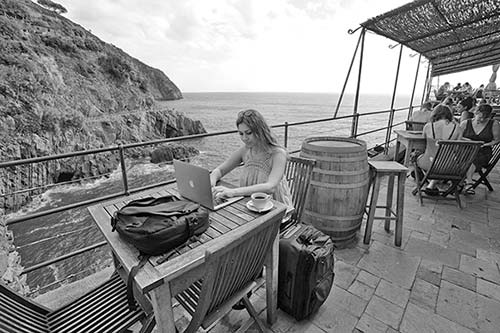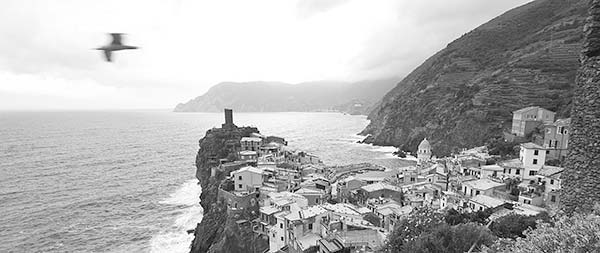
Monterosso al Mare • Vernazza • Corniglia • Manarola • Riomaggiore
Orientation to the Cinque Terre
Tucked between Genoa and Pisa, in a mountainous and seductive corner of the Italian Riviera, lies the Cinque Terre (CHINK-weh TAY-reh)—five villages carving a good life out of difficult terrain. With a traffic-free charm—a happy result of natural isolation—the Cinque Terre offers a rugged alternative to the glitzy Riviera resorts nearby.
Each village fills a ravine with a lazy hive of human activity. Calloused locals and sunburned travelers enjoy the area’s unique mix of Italian culture and nature. There isn’t a Fiat or museum in sight—just sun, sea, sand (well, pebbles), wine, and pure, unadulterated Italy. Choose a home base according to just how cut off you’d like to be from the outer world: resorty Monterosso, cover-girl Vernazza, hilltop Corniglia, photogenic Manarola, or amiable Riomaggiore.
This breathtakingly scenic six-mile stretch of coast was first described in medieval times as the “five lands” (cinque terre). Tiny communities grew up in the shadows of castles, which doubled as lookouts for pirate raids. As the threat of pirates faded, the villages prospered, catching fish and cultivating grapes. But until the advent of tourism in this generation, the towns remained isolated. Even today, each village comes with its own traditions, a distinct dialect, and a proud heritage. Other Italians think of locals here as “mountain people by the sea.”
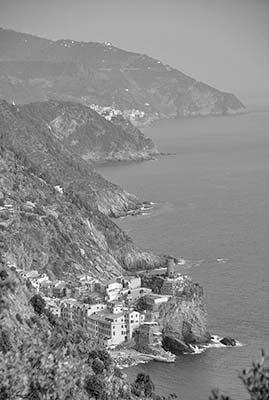
The Cinque Terre is now a national park (founded in 1999), where all can enjoy the villages, hiking, swimming, boat rides, and evening romance of one of God’s great gifts to tourism. While the region is well-discovered and can get jam-packed, I’ve never seen happier, more relaxed tourists.
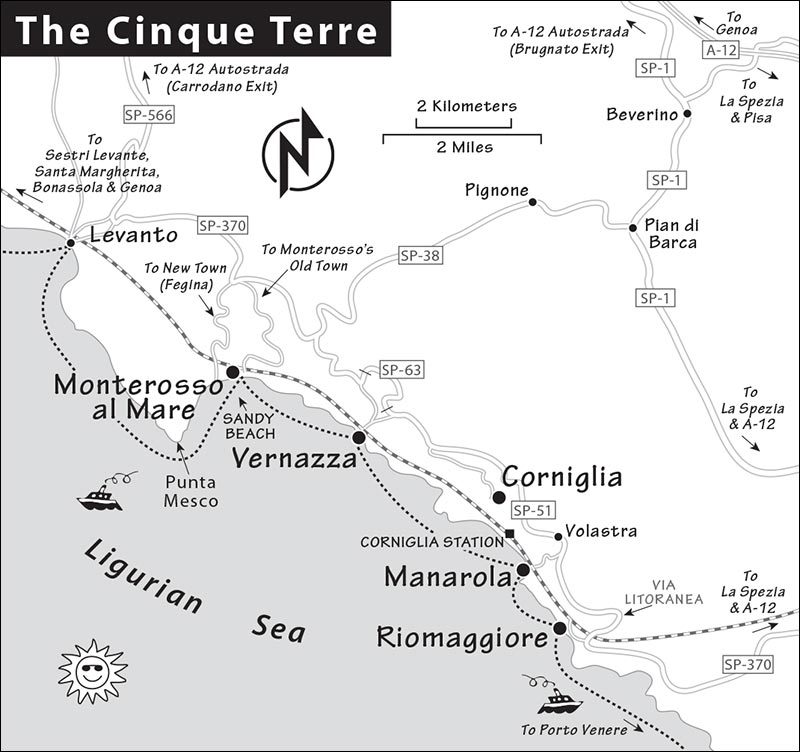
In this chapter, I cover general tips for your visit to the Cinque Terre, then describe the five towns in order from north to south—from Monterosso to Riomaggiore.
The ideal stay in the Cinque Terre is two or three full days; my recommended minimum stay is two nights and an uninterrupted day.
The villages are connected by trains, boats, and trails. There’s no checklist of sights or experiences—just a hike, the towns themselves, and your fondest vacation desires. Read this chapter in advance to piece together your best visit, mixing hiking, swimming, trains, and boat rides.
Cinque Terre in Two Days: You could spend one day hiking between towns (taking a boat or train part of the way, or as the return trip). Spend a second day visiting any towns you’ve yet to see, comparing main streets, beaches, and focaccia.
Here’s a sample day: If you’re based in Monterosso, take a morning train to Corniglia, hike to Vernazza for lunch (where you could explore the town, hike to the grand-view cemetery, or cool off at the beach), then catch the boat back to Monterosso to stroll the beach promenade. And that’s only one day out of dozens of memorable Cinque Terre combinations you can dream up.
On any evening, linger over dinner, enjoy live music at a low-key club (or summer opera in Vernazza), try a wine tasting, or follow one of my self-guided town walks. At sunset, take a glass of your favorite beverage out to the breakwater to watch the sun slip into the Mediterranean.
With More Time: You may be tempted to add the nearby resort towns of Levanto, Sestri Levante, Santa Margherita Ligure, and Portofino (to the north), and Porto Venere (to the south, anchored by the major transit hub of La Spezia; all described in the next chapter). If you carve out a day and an overnight for Santa Margherita Ligure, you can fit in an afternoon side trip to Portofino. A day trip to Levanto (by train or a hike from Monterosso) with an excursion to Bonassola and Framura is fun. For double the beaches, visit Sestri Levante. South of the Cinque Terre, lovely Porto Venere merits a day trip.
Day-Tripping to the Cinque Terre: Speed demons could store their baggage, take a hike in the morning, have a waterfront lunch, laze on a beach in the afternoon, and leave by evening to somewhere back in the real world. But be warned: The Cinque Terre is inundated with cruise-ship groups doing the same thing. The best way to enjoy the Cinque Terre is to be here before and after the daily day-trip deluge. (Ironically, some travelers decide against an overnight because they’ve heard the Cinque Terre is crowded—then day-trip in, only experiencing it with those terrible crowds.) The charm of the region survives—early and late.
When to Go: In early spring, from mid-March through April, the Cinque Terre is typically all yours. Later spring and fall are peak season, with the best weather and the most crowds. Book rooms ahead during the busiest times: holidays (including Easter weekend and April 25—Liberation Day), May, June, all summer weekends, September, and October.
July and August are hotter and generally a bit less crowded. The winter is really dead—most hotels and some restaurants close from November to mid-March.
Each town’s train station has a Cinque Terre national park information office, which generally also serves as an all-purpose town TI and gift shop. They can answer questions about trails (including conditions and closures), shuttle bus schedules, and so on.
Useful Websites: The park’s website is ParcoNazionale5terre.it. The “download” section of CinqueTerre.it has park info as well as boat and train timetables. A blog worth a look is CinqueTerreInsider.com, written by resident American expat Amy Inman; it’s filled with up-to-date practicalities for visitors to this always-in-flux region.
By Train: The five towns of the Cinque Terre are on a milk-run line, with trains coming through about every 30 minutes; most trains connect to the Cinque Terre from La Spezia or Genoa (local train info tel. 0187-817-458, www.trenitalia.com). Big, fast trains usually speed right past the Cinque Terre, although a few IC trains connect Monterosso to Milan or Pisa.
Unless you’re coming from another Cinque Terre town, you’ll change trains at least once to reach Manarola, Corniglia, or Vernazza. From the south or east, you’ll probably transfer at La Spezia’s Centrale station. From the north, you’ll transfer at Genoa’s Piazza Principe station, Sestri Levante, Levanto, or Monterosso.
For details on riding the train between Cinque Terre towns, see “Getting Around the Cinque Terre,” later; for information on arrival in each town, see the “Arrival” section for each town. For outbound trains, see “Monterosso Connections” on here and “La Spezia Connections” on here.
By Train After Parking Your Car: Don’t bring a car to the Cinque Terre; you won’t need it. Given the narrow roads and parking headache, the only Cinque Terre town I’d drive to is Monterosso (and then only if my hotel had parking). I could go on at great length about each town’s remote and often congested little parking lot (a shuttle-bus ride up the hill from that town), but for your own good, I’ll keep my advice short: Park your car in the nearest big city and take the train in—it’s safer, cheaper, faster, and smarter. Parking is easy in Levanto or La Spezia (La Spezia has a fine modern underground garage at the station; for details see the next chapter).
Pickpocket Alert: At peak times, the Cinque Terre can be notoriously crowded, and pickpockets (often female teens in groups of three or four, frequently dressed as tourists), aggressively and expertly work the most congested areas. Be on guard, especially in train stations, on platforms, and while you’re on trains, particularly when getting on or off with a crush of people. Wear a money belt, and keep your things zipped up and buttoned down.
Money: You’ll find ATMs and banks throughout the region. Use ATMs attached to actual banks. Shops earn a commission by hosting rip-off ATMs on their premises.
Markets: Market days perk up the Cinque Terre and nearby towns from around 8:00 to 13:00 on Tuesday in Vernazza, Wednesday in Levanto, Thursday in Monterosso, Friday in Santa Margherita Ligure, and Saturday in Sestri Levante.
Booking Services: Arbaspàa, based in Manarola, sets up wine tastings, cooking classes, fishing trips, and more (www.arbaspaa.com; see here). Cinque Terre Riviera, based in Vernazza, books rooms and apartments throughout the region, Vernazza opera tickets, cooking classes, and more (www.cinqueterreriviera.com; see here). BeautifuLiguria, run by Anna Merulla, offers various excursions (www.beautifuliguria.com).
Local Guides: These guides are knowledgeable, a delight to be with, and charge from €125/half-day and €210/day: Andrea Bordigoni (mobile 393-133-9409, bordigo@inwind.it) and Marco Brizzi (mobile 328-694-2847, marco_brizzi@yahoo.it).
Nightlife: There’s not much in this sleepy region, though Monterosso and Riomaggiore have lively late-night bars. For a little high culture, consider a Wednesday or Friday evening enjoying Vernazza’s summer opera series (see the Vernazza section).
Rainy Day Activities: Explore the towns, taking trains to connect them; splurge for a tasty meal; or nurse a coffee or drink at a harborfront café while watching the roiling waves. If you hike, avoid the steeper trails in the rain; rocks can be slippery.
Baggage Storage and Delivery: You can pay to store bags at or near the train stations in Monterosso, Vernazza, and Riomaggiore. Near the Cinque Terre, you can store bags in Santa Margherita Ligure and in La Spezia. See specifics per destination.
To transfer luggage from the station to your accommodations, call ahead and arrange with Roberto Pecunia; he’s based in Riomaggiore but works in any of the towns (mobile 370-375-7972).
Taxi: Cinqueterre Taxi covers all five towns (Matteo mobile 334-776-1946, Christian mobile 347-652-0837, www.cinqueterretaxi.com). The pricey 5 Terre Transfer service is handy if you need to connect the five towns or beyond (Luciana mobile 339-130-1183, Marzio mobile 340-356-5268, www.5terretransfer.com).
Within the Cinque Terre, you can connect towns by train, boat, or foot. Trains are the cheapest, fastest, and most frequent option. But don’t get stuck in a train rut: In calm weather, boats connect the towns nearly as frequently—and more scenically.
By train, the five towns are just a few minutes apart.
Tickets: A train ride between any two Cinque Terre towns costs €4. You must buy a new individual ticket for every train ride, and tickets are valid only on the day of purchase. You can buy tickets and check schedules online (www.trenitalia.com), at train-station windows or ticket machines, or at Cinque Terre park desks. When you buy a ticket, make a note of the train number, as that’s how the station monitors identify incoming and departing trains. Don’t wait to buy a ticket at the last minute: Ticket machines can be broken, and there can be very long lines at the window.
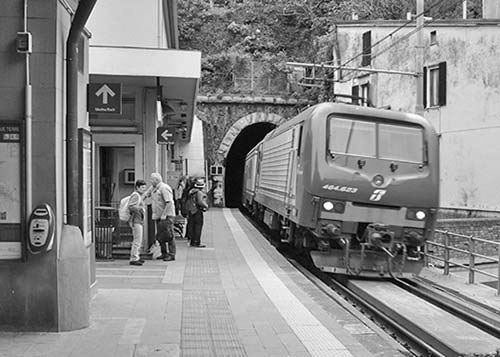
The €16 Cinque Terre Treno Card (described later, under “Hiking the Cinque Terre”) can be worthwhile even if you don’t hike, as it allows you to catch trains at the last minute without ticket concerns. It pays for itself if you take four rides in one day, but its value comes more from convenience than economy (https://card.parconazionale5terre.it).
Trains are covered by the Eurail Pass, but unless you have days to waste, it doesn’t make sense to use up a valuable travel day here, where train expenses are relatively low.
Using Tickets and Cards: Validate your ticket (or park card) before you board by stamping it in one of the green-and-white machines located on train platforms and in station passages. If you’re not sure how to do this, ask when you buy your ticket or card. Conductors here are notorious for levying stiff fines on tourists riding with an unstamped ticket. (Note that train tickets bought online or with the Trenitalia app are prevalidated—you don’t need to stamp them.)
Station Helpers: Red-vested track-side staff can answer your train-related questions. But be aware they are also there to keep crowds at bay as trains approach...and to nail travelers without tickets (they get a cut of the fines they levy).
Schedules: In peak season, trains connecting the five towns generally run two to three times hourly in each direction, but the frequency declines after about 20:00. Note that some trains do not stop at all five towns. Check schedules in advance.
Since the train is the Cinque Terre’s lifeline, shops, hotels, and restaurants often post the current schedule, and many hand out paper copies. Study the key to know which departures are only for weekdays, Sundays, and so on. These schedules also tell you which towns any given train will stop in. Trains from Levanto, Monterosso, Riomaggiore, or La Spezia sometimes skip lesser stations, so confirm that the train will stop at the town you need. (Note that train numbers starting with 21 or 24 generally stop at all five towns.)
At the Platform: Monitors display next departure times, listed by train number and final destination (but they do not show intermediate stops). They also show if a train is late—in ritardo—and by how many minutes; SOPP means “cancelled”. Trains are indicated by their final destination: Northbound trains are going to Levanto, Genova, or Sestri Levante; southbound trains are headed for La Spezia. To be sure you get on the right train, know your train’s number and final destination. Northbound trains use the tracks closest to the water; southbound trains use the tracks on the mountain side.
Getting Off: Know your stop. As the train leaves the town previous to the one where you want to get off, go to the door and get ready to slip out before the mobs flood in. If it’s crowded, you may need to be assertive. Say “permesso” (per-MEH-soh) and push on through. Note that stations are small and trains are long—you might have to get off deep in a tunnel, especially in Vernazza and Riomaggiore. If this happens, just head toward daylight. Also, train doors don’t open automatically—you may have to open the door yourself (push the green button, twist the black handle, or lift up the red one).
From Easter through October, a daily boat service connects Monterosso, Vernazza, Manarola, Riomaggiore, Porto Venere, and beyond. Though they can be very crowded, these boats provide a scenic way to get from town to town (operated by 5 Terre-Golfo dei Poeti, tel. 0187-732-987, www.navigazionegolfodeipoeti.it).
Because the boats nose in and tourists have to disembark onto little more than a plank, even just a small chop can cancel some or all of the stops.
Tickets: The ticket price depends on the length of the boat ride (€7 for a short hop, and up to €18 for a five-town, one-way ticket with stops). An all-day Cinque Terre pass costs €27; to add Porto Venere, it’s €35, plus an extra €5 for an optional 40-minute scenic ride around three small islands near Porto Venere (2/day). Buy tickets at the little stands at each town’s harbor.
Schedules: Boat schedules are posted online and at docks, harbor bars, Cinque Terre park offices, and hotels. Boats depart Monterosso about hourly (9:45-18:00), stopping at the Cinque Terre towns (except Corniglia, the hill town) and ending up about 90 minutes later in Porto Venere. Boats from Porto Venere to Monterosso run about 8:30-17:00. In high season, three boats per day depart from Levanto to Porto Venere.
Private Boats: To escape the crowds—or for a scenic splurge—hire a captain to ferry you between towns. For example, at the harbor in Vernazza, you can pay around €50 to hop to any other Cinque Terre town. Split the cost among a few fellow travelers, and you have an affordable water taxi. For a memorable and relaxing time on the water, you can hire a captain for a coastal tour, swimming excursion to a hidden cove, or a fishing trip (figure €150/1 hour). Or take a sunset aperitivo cruise (per-person charge; you should be able to join a 2-hour sightseeing cruise with drinks for around €50). Captains offer their services at the harbors in Monterosso, Vernazza, Manarola, and Riomaggiore (see specific listings in the Monterosso and Vernazza sections).
ATC shuttle buses (which locals call pulmino) connect each Cinque Terre town with its closest parking lot and various points in the hills (but they don’t connect the five towns to each other). The one you’re most likely to use runs between Corniglia’s train station and its hilltop town center. Rides cost €1.50 (€2.50 from driver), and are covered by the Cinque Terre park card (described in next section). Buy tickets and get bus schedules at park info offices or TIs, or check times posted at bus stops (also online at www.atcesercizio.it). As you board, it’s smart to tell the driver where you want to go. Departures often coordinate with train arrival times.
Some shuttles go beyond the parking lots and high into the hills—often terminating at the town’s sanctuary church. To soak in the scenery, you can ride up and hike down. This works particularly well from Manarola and Vernazza. Or you can ride both ways (50 minutes round-trip, covered by one ticket).
The five Cinque Terre towns are connected by a main coastal trail and a web of trails higher up. The main coastal trail has four sections—two that are open (Monterosso to Vernazza, and Vernazza to Corniglia) and two that are closed (Corniglia to Manarola, and Manarola to Riomaggiore—the famed “Via dell’Amore”). Also closed is the alternate Riomaggiore-Manarola trail (via “La Beccara”).
With only half the trails open and so many day-trippers blitzing in with the same hiking agenda, you’ll want to enjoy the region’s most popular hikes on the lower trail (from Vernazza to Monterosso, or from Corniglia to Vernazza) early or late. The single best high-country hike is from Manarola to Corniglia via Volastra (you can ride the ATC shuttle bus from Manarola to the high point at Volastra and hike scenically downhill to Corniglia). These hikes take roughly 1.5-2 hours and are described next.
Cinque Terre Park Cards: Visitors hiking on the main coastal trail must buy a park card. Cards are not needed to hike on higher trails. Cards can be purchased online, or at train stations, TIs, and trailheads, and are good for 24 or 48 hours after validation (www.parconazionale5terre.it). Some area hotels sell discounted park cards to guests—be sure to ask.
The Cinque Terre Trekking Card costs €7.50 for one day of hiking or €14.50 for two days (covers trails, free use of WCs, park Wi-Fi, and ATC shuttle buses, but not trains).
The Cinque Terre Treno Card covers what the Trekking Card does, but also includes local trains connecting all Cinque Terre towns, plus Levanto and La Spezia (€16/24 hours, €29/48 hours, validate card at train station by punching it in the machine). Even if you’re not planning to hike, this card can be worth it just to save you time on buying train tickets.
Navigation: Trails are marked with red-and-white paint, white arrows, and some signs (sentiero means trail). The main coastal trail is variously indicated as “SVA,” “the Blue Trail,” or #592. Maps aren’t necessary for the basic coastal hikes. But for the more challenging routes that leave the crowds behind, pick up a good hiking map (about €5, sold everywhere).
Hiking Conditions: In general, trails are narrow, steep, rocky, and come with lots of challenging steps. Don’t overestimate your hiking abilities. I get many emails from readers who say the trails were tougher than they’d expected. The rocks and metal grates can be slippery in the rain. Don’t venture up on these rocky cliffs without sun protection (and/or a hat), water, and proper shoes (flip-flops are not allowed). Pace yourself. While the main coastal trail is strenuous, it’s doable for any fit hiker...and the scenery is worth the sweat.
Before embarking on the more difficult hikes, get advice from one of the national park offices (located at each train station), or from Cinque Terre Trekking in Manarola (see here).
When to Go: The coastal trail can be extremely crowded and very hot at midday. For the best light, coolest temperatures, and fewer crowds, start your hike early (by 8:00) or late (around 16:00 or 17:00). Before setting out for an evening hike, find out when the sun will set, and leave plenty of time to arrive at your destination before then; there’s no lighting on the trails.
Shuttle Buses: ATC shuttle buses can make the going easier, connecting coastal villages to trailheads higher up. Locals know all the options—and shuttle bus schedules—so ask around. But be aware that shuttles heading into the high country only run in summer, and just once or twice a day. If frustrated with bus schedules, try the local taxis.
Guided Hikes and Excursions: Your park card includes guided hikes and other local excursions (such as town walking tours), which take place almost daily in the summer months. Even without a valid park ticket, these events are affordable—usually around €6. Look for schedules locally, or email visiteguidate@ati5terre.it for details.
These three hikes each give the quintessential Cinque Terre hiking experience. The first two are part of the main coastal trail (and require the national park card); the third takes you much higher (and is free).
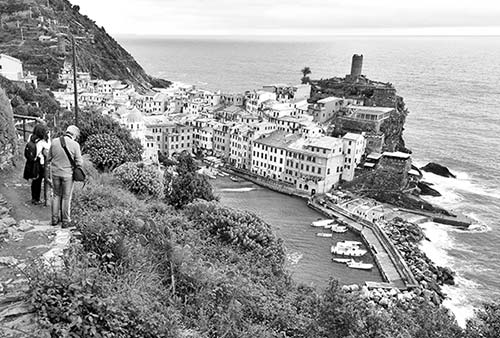
The scenic up-and-down-a-lot trek from Vernazza to Monterosso is both challenging and rewarding. The trail is narrow, steep, and crumbly in spots, with a lot of steps but easy to follow. The views just out of Vernazza, looking back at the town, are spectacular. From there you’ll gradually ascend to 550 feet, passing some scenic waterfalls populated by croaking frogs. As you approach Monterosso, you’ll descend steeply through vineyards—on very deep, knee-testing stairs—and eventually follow a rivulet to the sea. The last stretch is along a pleasant, paved pathway clinging to the cliff. You’ll pop out right at Monterosso’s refreshing old-town beach.
The hike from Corniglia to Vernazza—the wildest and greenest section of the coast—is very rewarding but very hilly. From the Corniglia train station, zigzag up to the town (via the steep stairs, the longer road, or the shuttle bus). From Corniglia, you’ll reach the trailhead on the main road, past Villa Cecio. You’ll hike through vineyards toward Vernazza. After about 10 minutes, you’ll see a faded sign to Guvano beach, far beneath you (formerly a nude beach—now closed). The scenic trail continues through lots of fragrant and flowery vegetation into Vernazza. If you need a break before reaching Vernazza, stop at Bar la Torre, with a strip of amazingly scenic and delightfully shady tables perched high above the town.
This challenging hike from Manarola leads up to the village of Volastra, then north through high-altitude vineyard terraces, and steeply down through a forest to Corniglia. You can shave the two steepest miles off this route by taking the ATC shuttle bus from Manarola up to Volastra (about hourly, 15-minute trip).
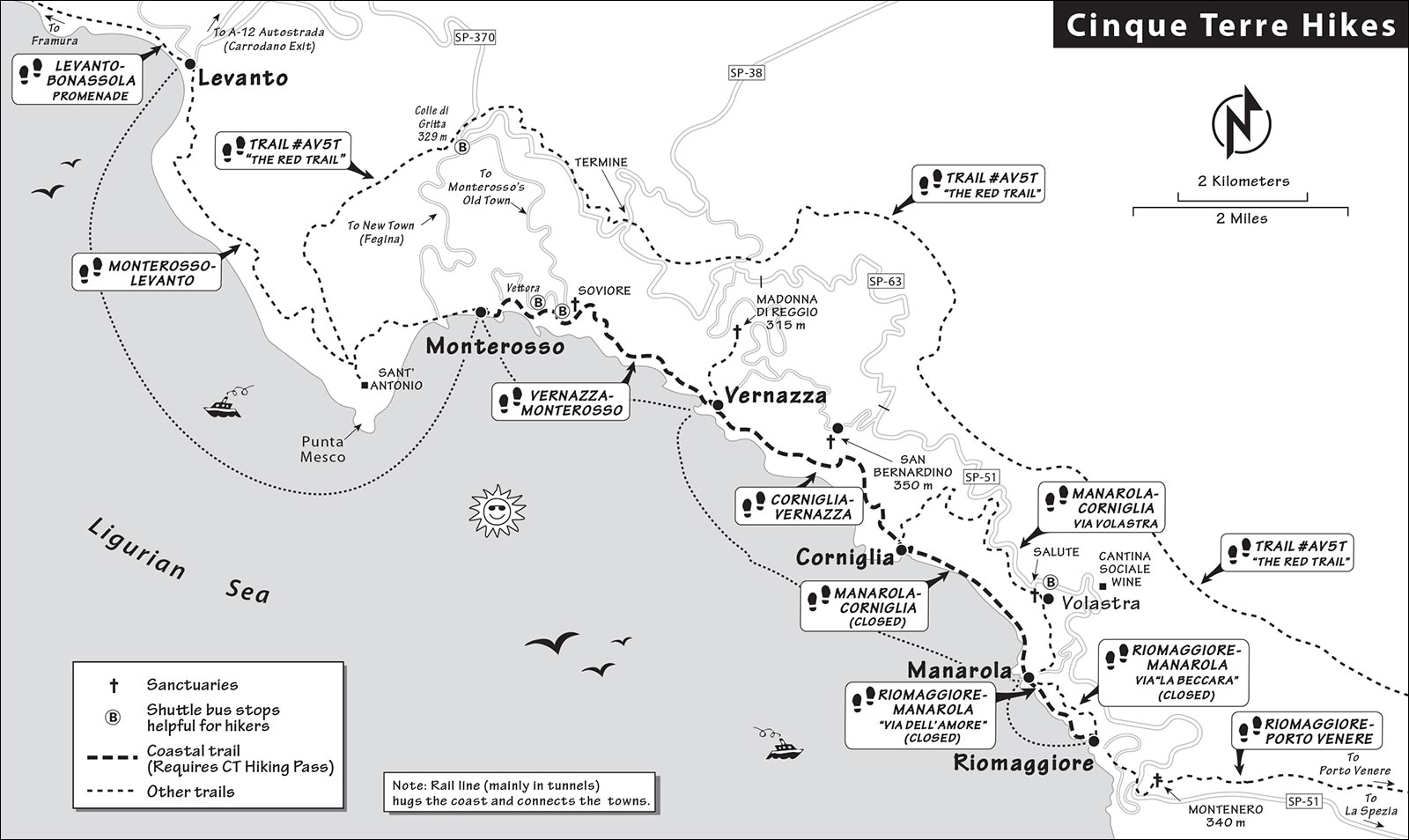
If you’d rather hike to Volastra, you have two options: The national park’s official route (trail #506) cuts up through the valley. Locals have cleared a more scenic but rougher alternate route that begins with the vineyard hike on my self-guided walk for Manarola (here); partway along this walk, where you reach the wooden religious scenes scampering up the hillside, take a sharp right and walk uphill, following signs for Panoramico Volastra (Corniglia). While steeper than the official route, this trail follows the ridge at the top of the vineyard, with wonderful sea views.
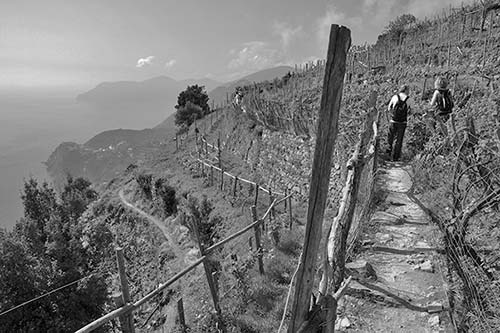
Tiny Volastra, perched between Manarola and Corniglia, hosts lots of Germans and Italians in the summer. Just below town, in the hamlet of Groppo, is Cantina Sociale, a cooperative winery open to the public (wine tastings, www.cantinacinqueterre.com). When you’re ready to head for Corniglia, make your way to the village church (where the shuttle bus drops off) and look for Corniglia signs. From the front door of the church, directly across the piazza, find the trailhead (marked by an iron cross) for trail #586 to Case Pianca.
Here begins one of the region’s finest hikes, tight-roping along narrow trails tucked between vineyard terraces, with spectacular bird’s-eye views over the entire Cinque Terre. You’ll cut up and down the terraces a bit—just keep following the red-and-white markings and arrows. After passing a little village (and following signs through someone’s seaview backyard), the trail enters a forest and begins its sharp, rocky descent into Corniglia. (To skip the descent, backtrack to Volastra and return by shuttle bus to Manarola.) High above Corniglia, you’ll reach a fork, where you turn left to proceed downhill on trail #587 to Corniglia.
Beyond the main coastal trail, the national park maintains a free, extensive network of trails. The Cinque Terre Park Card is not required for the following hikes.
The most challenging hikes (between Riomaggiore and Porto Venere, and the high route linking Porto Venere and Levanto) are best for very experienced hikers who are equipped with hiking boots, poles, a phone for emergencies, plenty of water, and a good map. Before attempting these hikes, get detailed local advice.
This strenuous, rugged-and-wild hike on the coastal trail (SVA) will take you all the way into Levanto. Wear good shoes and bring lots of water.
Starting from Monterosso, look for signs for the coastal trail at the west end of the new town, and head steeply up. You’ll hike up and over Punta Mesco, the bluff that separates the two towns. The first stretch, out of Monterosso, is almost entirely big steps; the rest is mostly a gradual up-and-down.
For a short scenic detour, look for trail #591 not far out of Monterosso. This brief jog leads to the ruined chapel of Sant’Antonio.
To begin the hike in Levanto, see here.
Alternate Route: You can enjoy a higher hike by skipping the steepest stretch and riding one of Monterosso’s shuttle buses to Colle di Gritta (and Hotel Monterosso Alto). From there, follow trail #591 along the ridge and down to Colle di Bagari, where several trails intersect. You can follow trail #571c from here or go a little lower to #571—both head down to trail SVA and Levanto. Or, to make your hike a loop that returns directly to Monterosso, continue from Colle di Bagari along trail #591 to trail SVA, and drop steeply into Monterosso.
For an easy excursion, take the train to Levanto, then stroll (or better yet, bike) the level, rails-to-trails promenade to the beach town of Bonassola (see the next chapter).
From Bonassola (described above), the path (good for biking) continues through a series of tunnels to Framura, a cluster of small villages. You can take the scenic coastal trail to a small beach or hike up the road to the villages.
For this challenging trek, you’ll hike up from Riomaggiore on trail #593 (a continuation of the coastal trail SVA) to the sanctuary at Montenero, then up to Colle del Telegrafo; and then all the way down to Porto Venere on trail AV5T. Partway along, the town of Campiglia has a little bar/restaurant (and buses to La Spezia).
Above the coastal trails, and higher than the sanctuary trails, is the demanding 22-mile AV5T trail (alta via 5 Terre, also labeled trail #1 or #591/598). It connects Porto Venere to Levanto, offering sky-high views over the Cinque Terre seafront. Also called the Red Trail, it’s cool, uncrowded, and at the top of the world. You could do all or part of this trail.
For each Cinque Terre town, I include a self-guided walk to help you explore the town (anytime, day or night). Manarola’s is the most scenic, offering an easy, rewarding stroll through vineyards with stunning views. Per town, I also list a few easy hiking options, even as simple as walking just outside town to get a lovely overview looking back (e.g., for Vernazza and Manarola).
Each of the five towns has its own sanctuary (with a chapel or church dedicated to the Virgin Mary), hovering in the hills a mile or two above town, and accessible by a long, steep hike (quiet and uncrowded). The sanctuaries were a place of refuge for each village in the age of pirate attacks.
Villagers feel deeply connected to these spiritual retreats, where they remember lost relatives and feel part of a timeless community. A network of “sanctuary trails” (no hiking card required) crisscrosses the hills above the main coastal route. There’s no single path, but with a good map you can link up these moderately difficult trails. In most towns, the shuttle bus can take you from the town center to the sanctuary—you could ride up and hike down (described with each town’s coverage next).
Accommodations in the popular Cinque Terre cost more than in other villages and are packed on holidays (especially Easter weekend and April 25); when the weather is best (May, June, Sept, and Oct); and on Fridays and Saturdays all summer (though July and Aug can be less crowded due to sweltering heat). During these busy periods, you must reserve ahead.
Vernazza, the spindly and salty essence of the Cinque Terre, is my top choice for a home base. And its summer opera series has beefed up its nightlife. But if you think too many people have my book, you’ll get fewer crowds and better value for your money in other towns.
Monterosso is a good choice for sun-worshipping beach lovers, those who prefer the ease of a real hotel, and a youthful crowd interested in nightlife.
Manarola, charming and not overrun, draws serious hikers and sophisticated Europeans. The town has a good range of professional-feeling small accommodations, but fewer dining and evening options.
Riomaggiore, one of the biggest Cinque Terre towns, has the cheapest beds and rivals Monterosso for nightlife, but it’s more Italian than Rivieran.
Corniglia, on a hilltop (no beach), attracts hermits, anarchists, wine lovers, and mountain goats.
Private Rooms for Rent (Affittacamere): Many accommodations in the Cinque Terre (especially in Vernazza) are affittacamere, or private rooms for rent. These range from simple bedrooms with shared baths, to fancy bedrooms with private baths, to comfortable apartments (often with small kitchens). You get a key and come and go as you like, typically rarely seeing your landlord. Plan on paying cash. If you must cancel an affittacamere reservation, do it as early as possible—since people renting rooms usually don’t take deposits, they lose money if you don’t show up.
Amenities: Breakfast is not included at most affittacamere and other simple accommodations. (Locals take breakfast about as seriously as flossing.) The basic, very Italian choice is simply to drop by a neighborhood bar for a cappuccino and a cornetto (croissant) or a piece of focaccia. Some pricier places include breakfast, but this often consists of a few paltry items (packaged croissants, yogurt, instant coffee) in a minifridge in your room.
While air-conditioning is essential in the summer elsewhere in Italy, in the breezy Cinque Terre you can generally manage fine without it. Expect thin walls (pack earplugs).
Hanging out at a seaview restaurant while sampling local specialties could become one of your favorite Cinque Terre memories.
The key staple is anchovies (acciughe; ah-CHOO-gay)—ideally served the day they’re caught. If you’ve always hated anchovies (the slimy, salty kind), try them fresh here. They’re prepared in a dizzying variety of ways: marinated, salted, drenched in lemon juice, butterflied and deep-fried (sometimes with a tasty garlic/vinegar sauce called giada), and so on.
Tegame alla vernazzana is the most typical main course in Vernazza: a layered, casserole-like dish of whole anchovies, potatoes, tomatoes, white wine, oil, and herbs.
Seafood is plentiful. You’ll often see muscoli ripieni (stuffed mussels) on menus. And, while antipasto means cheese and salami in Tuscany, here you’ll get antipasti frutti di mare (or simply antipasti misti): a plate of mixed “fruits of the sea.” Many restaurants are proud of their frutti di mare—it’s how they show off—and it’s a fine way to start a meal. For two diners, splitting one of these and a pasta dish can be plenty.
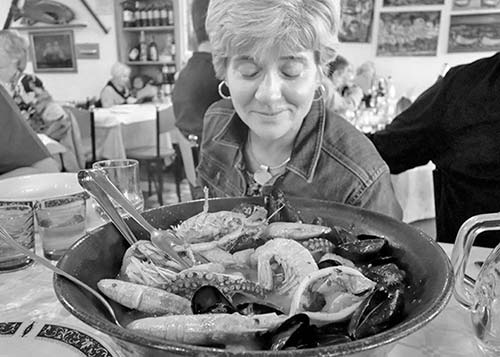
This region is the birthplace of pesto. Basil, which loves the temperate Ligurian climate, is ground with cheese (half parmigiano and half pecorino), garlic, olive oil, and pine nuts, and then poured over pasta. You’ll see it on gnocchi or on pasta designed specifically for pesto to cling to: trenette (ruffled on one side) or trofie (short, dense twists). Many also like pesto lasagna, made with white sauce.
Pansotti are ravioli with ricotta and a mixture of greens, often served with a walnut sauce (salsa di noci)...delightful and filling.
Focaccia—pillowy, flat, salty, olive-oily bread—also originates here in Liguria. The baker roughs up the dough with finger holes, sprinkles it with salt water, then bakes it. Focaccia comes plain or with onions, sage, or olives, and is a local favorite for a snack on the beach. Bakeries sell it in rounds or slices by weight (a portion is about 100 grams, or un etto).
Farinata, a humble flatbread snack sold at pizza and focaccia places, is made from chickpea flour, water, oil, and pepper and baked on a copper tray in a wood-burning stove. It’s dense, filling, and less flavorful than focaccia.
The region also loves its locally grown lemons. The popular lemon liqueur is called limoncino (a.k.a. limoncello).
Vino delle Cinque Terre, while not one of Italy’s top wines, flows cheap and easy throughout the region. It’s white—crisp, refreshing, and great with seafood. Local wines are typically blends, predominantly using the bosco grape, found only here. As local wine has become more sophisticated and appreciated lately, there are now plenty of wine bars that offer tasting experiences.
For a sweet but potent dessert wine, sciacchetrà (shah-keh-TRAH) is worth a try (18 percent alcohol, often served with dunkable cookies). While 10 kilos of grapes yield 7 liters of local wine, sciacchetrà is made from near-raisins: 10 kilos make only 1.5 liters of the wine. The word means “push and pull”—push in lots of grapes, pull out the best wine.
Monterosso al Mare—the only Cinque Terre town with some flat land—has two parts: A new town (called Fegina) with a parking lot, train station, and TI; and an old town (Centro Storico), which cradles Old World charm in its small, crooked lanes. In the old town, you’ll find hole-in-the-wall shops, rustic pastel townscapes, and a new generation of creative small-businesspeople eager to keep their visitors happy. A handy pedestrian tunnel connects the old with the new.
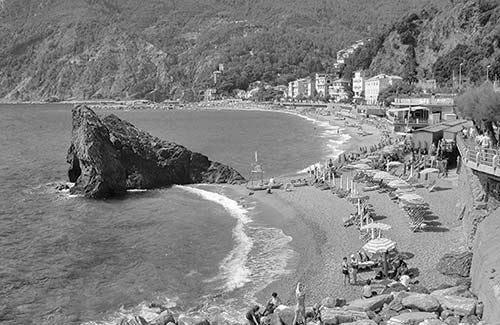
This is a resort town with a few cars and lots of hotels, rentable beach umbrellas, and crowds. Strolling the waterfront promenade, you can pick out each of the Cinque Terre towns decorating the coast. After dark, they sparkle. Monterosso is the most enjoyable of the five for backpackers or the young-at-heart wanting to connect with others looking for a little nightlife.
The TI, called Proloco Monterosso, is on the street below the train station (daily 9:00-18:30, longer hours in summer, shorter hours off-season, baggage storage, exit station and go left a few doors, tel. 0187-817-506, www.prolocomonterosso.it). Upstairs within the station you’ll find a Cinque Terre park info desk and a ticket office near platform 1 (both usually daily 8:00-20:00, shorter hours off-season).
By Train: Train travelers arrive in the new town. To reach most of my recommended hotels in the new town, turn right from the station. To get to the old town, turn left from the station, follow the seafront promenade, then duck through the tunnel just before the point—it’s a scenic, flat 10-minute stroll.

The bar at track 1 (serving salads, sandwiches, and drinks) overlooks both the tracks and the beach, and is a handy place with a cool breeze to hang out while waiting for a train to pull in. As many trains run late, this can turn a frustration into a blessing.
Taxis usually wait outside the train station, but if not, you can call one (€10 from station to old town, mobile 335-616-5842, 335-616-5845, or 335-628-0933). ATC shuttle buses also go to the old town and are cheaper, but only run about once an hour.
By Car: Monterosso is 30 minutes off the freeway (exit: Carrodano-Levanto). About three miles above Monterosso, there’s an intersection where you must choose either Monterosso Centro Storico (old part of town) or Monterosso Fegina (new town and beachfront parking). Know where you want to go, because you can’t drive directly between the new town and old center (the tunnel is closed to most cars).
Get directions from your hotelier. Most drivers should choose the Fegina fork. Parking is easy (except July-Aug and weekends in June) in the new town in the huge beachfront guarded lot (€25/24 hours). In the old town, you’ll find the Loreto parking garage on Via Roma, from which it’s a 10-minute downhill walk to the main square (€2/hour, €20/24 hours).
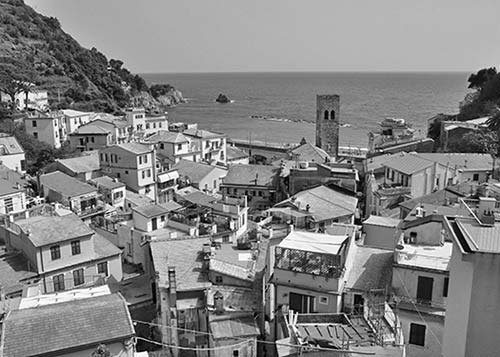
Medical Help: The town’s bike-riding, leather bag-toting, English-speaking physician is Dr. Vitone (simple visit-€50-100, less for poor students, mobile 338-853-0949, vitonee@yahoo.it).
Market: Every Thursday morning (8:00-13:00), trucks pull into the old town and fill the public area by the beach with stalls selling produce and more.
Baggage Storage: The TI will store bags (€6/day—but confirm closing time).
Laundry: For full-service, same-day laundry in the new town, try Wash and Dry Lavarapido. They’ll pick up at your hotel, or you can drop it at their shop. The owners speak little English, so ask your hotelier to arrange the details (daily 9:00-19:00, Via Molinelli 17, mobile 339-484-0940, Lucia and Ivano). In the old town, head to Luètu Lavanderia, uphill on Via Roma and across from the post office (daily 8:00-20:00, maybe later in summer, tel. 328-286-1908).
Massage: Physiotherapist Giorgio Moggia gives good massages at your hotel or in his studio (€70/hour, mobile 339-314-6127, giomogg@tin.it).
These self-guided walks will introduce you to Monterosso. The first one, focusing on the mostly level town center, takes about 30 minutes. For the second one, you’ll summit the adjacent hill—allow an hour or so.
• Let’s begin with an easy sweep of the sights: Hike out from the dock in the old town and stand atop the concrete breakwater. (If you’re arriving by boat, you’ll disembark here.)
From this point you can survey Monterosso’s old town (straight ahead) and new town (stretching to the left, with train station and parking lot). Notice the bluff that separates old and new, and imagine how much harder your commute would be if the narrow road tethering these two towns were somehow cut off. It happened in the spring of 2013, when the wall below the hill-topping Capuchin church gave way in a landslide. For a time, the only way to connect the two halves of town by car was to drive six miles around; on foot, you had to hike up and over this hill. (The little fort halfway up the hill, which dates from 1550, is now a fancy restaurant, with a private home upstairs.)
Looking to the right, you can see all cinque of the terre from one spot: Vernazza, Corniglia (above the shore), Manarola, and a few buildings of Riomaggiore beyond that.
These days, the harbor hosts more paddleboats than fishing boats. Erosion is a major problem. The partial breakwater—the row of giant rocks in the middle of the harbor—is designed to save the beach from washing away. While old-timers remember a vast beach, their grandchildren truck in sand each spring to give tourists something to bask on. (The Nazis liked the Cinque Terre, too—find two of their bomb-hardened bunkers embedded in the bluff. During World War II, nearby La Spezia was an important Axis naval base, and Monterosso was bombed while the Germans were here.)
The fancy four-star Hotel Porto Roca (the pink building high on the hill, on the far right of the harbor) marks the trail to Vernazza. High above, you see an example of the costly roads built in the 1980s to connect the Cinque Terre towns with the freeway over the hills.
The two prominent capes (Punta di Montenero to the right, and Punta Mesco to the left) define the Cinque Terre region. The closer Punta Mesco is part of a protected marine sanctuary and home to a rare sea grass that provides an ideal home for fish eggs. Buoys keep fishing boats away. The cape was once a quarry, providing employment to locals who chipped out the stones used to build the local towns (the greenish stones making up part of the breakwater are from there).
On the far end of the new town, marking the best free beach around, you can just see the statue named Il Gigante (hard to spot because it blends in with the gray rock). It’s 45 feet tall and once held a trident. While it looks as if it were hewn from the rocky cliff, it’s actually made of reinforced concrete and dates from the beginning of the 20th century, when it supported a dancing terrace for a fin de siècle villa. A violent storm left the giant holding nothing but memories of Monterosso’s glamorous age.
• From the breakwater, walk toward the old town (noticing the big drainage tunnels opening onto the beach—critical to avoid flooding during big rainstorms) and under the train tracks. Then venture right into the square and find the statue of a dandy holding what looks like a box cutter (near the big playground).
The statue honors Giuseppe Garibaldi, the dashing firebrand revolutionary who, in the 1860s, helped unite the people of Italy into a modern nation. Facing Garibaldi, with your back to the sea, you’ll see (on your right) the orange City Hall (with the European Union flag beside the Italian one). You’ll also see A Ca’ du Sciensa restaurant, which has historic town photos inside and upstairs; you’re welcome to pop in for a look.
Just under the bell tower (with your back to the sea, it’s on your left), a set of covered arcades facing the sea is where the old-timers hang out (they see all and know all). The crenellated bell tower marks the church. This was originally the tower of a fortified gate that protected the town back in the days when they hid out of view of marauding pirates.
• Go to church.
First, walk along the right side the church. Near the second side door, find the high-water mark (altezza massima) from an October 1966 flood—which also famously devastated Florence. Nearby, a second (higher) plaque commemorates the 2011 flood.
Now hook left, around the church—and appreciate its black-and-white-striped main facade. With white marble from Carrara and green marble from Punta Mesco, the church is typical of the region’s Gothic style. The church’s marble stripes get narrower the higher they go, creating the illusion that the church is taller than it really is. Note the lacy, stone rose window above the entrance—considered one of the finest in northern Italy. It’s as delicate as crochet work, with 18 slender columns (creating the petals of the rose).
Step inside for more Ligurian Gothic: original marble columns and capitals with pointed arches to match. The octagonal baptismal font (in the back of the church) was carved from Carrara marble in 1359. Imagine the job getting that from the quarries, about 40 miles away. The fine Baroque altar was crafted with various marbles from around Italy in the 1700s. The church itself dates from 1307—the proud inscription on the left-middle column reads “MilloCCCVII.”
• Leaving the church, turn left and go to church again.
During the Counter-Reformation, the Catholic Church offset the rising influence of the Lutherans by creating brotherhoods of good works. These religious Rotary clubs were called “confraternities.” Monterosso had two, nicknamed White and Black. This building is the oratory of the Black group, whose mission—as the macabre decor filling the interior indicates—was to arrange for funerals and take care of widows, orphans, the shipwrecked, and the souls of those who ignore the request for a €1 donation. It dates from the 16th century, and membership has passed from father to son for generations. Notice the fine, carved pews (c. 1700, with toothy smiling skulls reminding us that mortality is nothing to fear), just inside the door, and the haunted-house chandeliers. Look up at the ceiling to find the symbol of the confraternity: a skull-and-crossbones and an hourglass...death awaits us all.
• On that cheery note, if you’re in a lazy mood, you can end your walking tour here to enjoy strolling, shopping, gelato-licking, a day at the beach...or all of the above. But if you’re up for a hike, face out to sea, look to the right and imagine the view from the top of that hill. Now...go see it.
The hill that separates the old town from the new rewards anyone who climbs up with a peaceful church, a cemetery in the clouds, and a panoramic view.
• From the old town’s beachfront, find the brick steps squeezed between Hotel Pasquale and its restaurant, and start climbing. The lane is signed Salita dei Cappuccini (nicknamed Zii di Frati), or...
Follow the yellow brick road (OK, it’s orange...but I couldn’t help singing as I skipped skyward). Partway up, detour left to the terrace above the seaside castle at a statue of St. Francis and a wolf taking in a grand view. Enjoy an opportunity to see all five of the Cinque Terre towns. Then backtrack 20 yards to the switchback and continue uphill. (If you continue straight on from St. Francis, you’ll drop down into the new town.)
• When you reach a gate marked Convento e Chiesa Cappuccini, you have arrived at the...
The former monastery is now manned by a single caretaker friar. (If you meet Father Renato, take a moment to speak with him—he’s a joyful soul who loves to connect.) Before stepping inside, notice the church’s striped Romanesque facade. It’s all fake. Tap it—no marble, just cheap 18th-century stucco. Go inside and sit in the rear pew. The high altarpiece painting of St. Francis can be rolled up on special days to reveal a statue of Mary standing behind it.
The fine painting of the Crucifixion (on the left) recalls how, when Jesus died, the earth went dark. Notice the eclipsed sun in the painting, just to the right of the cross. Do the electric candles work? Pick one up, pray for peace, and plug it in. (Leave an offering, or unplug it and put it back.)
• Leave and turn left through another gate to hike 100 yards uphill to the cemetery filling the ruined castle at the top of the hill. Reaching the cemetery’s gate, look back and enjoy the view over the town.
In the Dark Ages, the village huddled behind this castle. As the threat of pirates passed, it slowly expanded to the waterfront. Notice the town view from here—no sea. You’re looking at the oldest part of Monterosso, tucked behind the hill, out of view of 13th-century pirates.
Respectfully explore the cemetery. Ponder the black-and-white photos of grandparents past. Read the headstones: Q.R.P. is Qui Riposa in Pace (a.k.a. R.I.P.). Rich families had their own little tomb buildings. That this is still a place treasured by the living is demonstrated by the abundance of fresh flowers.
Climb to the very summit—the castle’s keep, or place of last refuge. Priests are buried in a line of graves closest to the sea, but facing inland, looking toward the town’s holy sanctuary high on the hillside (above the road, with its triangular steeple just peeking above the trees). Each Cinque Terre town has a lofty sanctuary, dedicated to Mary and dear to the village hearts.
• Your tour is over—any trail leads you back into town.
For a relatively easy in-town hike, take a rewarding climb up to the hilltop cemetery between the old and the new towns (described above).
Several ambitious hikes begin in Monterosso; you can use ATC shuttle buses to make challenging hikes easier (for details, see here).
If you’re hiking to Vernazza on the main coastal trail, you’ll need a park card (sold at the trailhead). If heading north over the Punta Mesco bluff to Levanto, you can take the bus up to Colle di Gritta—which makes most of the rest of the hike downhill. (For more on these hikes, see “Hiking the Cinque Terre,” earlier.)
You can hike to Monterosso’s Soviore sanctuary (on trail #509) or take the shuttle bus. To hike from Soviore to Vernazza’s Madonna di Reggio sanctuary, follow a mostly level trail (#591) to Termine, then head down to Madonna di Reggio (on #582), then steeply downhill into Vernazza (on #508). Allow 2.5 hours, if you start with the shuttle bus.
Monterosso’s new town has easily the Cinque Terre’s best—and most crowded—beach (immediately in front of the train station). Most of the beach is technically private, where (at Stella Marina) you’ll pay €20 to rent two chairs and an umbrella for the day (prices get soft in the afternoon). Light lunches are served by beach cafés to sunbathers at their lounge chairs. Various outfits along here rent kayaks and stand-up paddleboards (look for signs at the west end of the beach—near the parking lot—or ask around). If there are no umbrellas on a stretch of beach, it’s public (free), so you can spread out a towel anywhere. There’s a free beach at the far west end, near the Gigante statue; others are marked on the “Monterosso al Mare” map, earlier.
The old town also has its own predominantly private beach; rent umbrellas, chairs, kayaks, and paddleboats from Beach Bar Alga (run by Stefano, €35 for two including showers, changing room, WC, two lounge chairs, and an umbrella), which is also a scenic spot for a drink. Tucked just beyond the private beach—under the Il Casello restaurant at the east end of town—is the free public beach called Tragagià, which is gravelly and generally less crowded (showers). The bocce ball court (next to Il Casello) is busy with older men enjoying their favorite pastime.
Buranco Agriturismo is one of the largest producers of wines in the Cinque Terre, and they welcome visitors to tastings on their expansive terrace with views over the vineyards. You’ll taste some of their wines plus grappa (firewater) and limoncino, while snacking on bruschetta, olives, and the like. It’s best to call or email ahead to let them know you are coming (€20-30/person with snacks, tastings usually daily 12:00-18:00, follow Via Buranco uphill to path, 10 minutes above town, also rents recommended apartments, mobile 349-434-8046, www.burancocinqueterre.it, info@buranco.it, Mary).
Enoteca Internazionale is a good place in town to sample local wines. Mario is very knowledgeable and serves a selection of five wines for €20 (his bruschetta makes a fine light meal as you’re sipping, open daily until late, Via Roma 62, tel. 0187-817-278).
In addition to the regularly scheduled big boats (see here), you can hire your own captain for transfers to other towns or for a lazy sightseeing cruise (if the water’s calm).
Stefano has two six-person boats: the Matilde and the Babaah (about €100/hour, 90 minutes is enough for a quick spin, two hours includes time for swimming stops; longer trips to Porto Venere and offshore islands possible; mobile 333-821-2007, www.matildenavigazione.com, info@matildenavigazione.com).
Diego offers half-day, daylong, and sunset excursions for up to seven on his cushy boat. Longer tours can include snorkeling, village visits, and a buffet lunch onboard (group tours—€70, daily 10:30-13:30 & 17:30-20:30, best to email or call to confirm and reserve; private tours—€120/hour for up to 4 people, €150/hour for 5-7 people; mobile 339-233-9297, www.cinqueterreboat.com, 5terretourfishandchill@gmail.com).
Sea Breeze Boat Tours arranges day and aperitivo sunset tours, and will shuttle you to any of the coastal towns. They also run tours from Levanto (€85-140/person, mobile 328-824-6889 or 338-809-9278, www.seabreezeboattours.com, info@seabreezeboattours.com, Matteo and Federica).
Although I’ve listed these establishments for their nightlife, they work any time of day for a drink and spot to relax.
Enoteca da Eliseo, my favorite wine bar in town, comes with operatic ambience. Eliseo and his wife, Mary, love music and wine. Taste by the glass (bicchiere), or select a fine bottle from their shop shelf, then enjoy the wine, a few included nibbles, and views of the village action from their cozy tables. Eliseo stocks more than a hundred varieties of grappa (Wed-Mon 14:00-23:30, closed Tue, Piazza Matteotti 3, a block inland behind church, tel. 0187-817-308).
Fast Bar is super basic, but it’s the best bar in town for young travelers and night owls. Customers mix travel tales with big, cold beers, and the crowd (and the rock ’n’ roll) gets noisier as the night rolls on. Come here to watch Italian or American sporting events on TV all day (cheap panini, salads, and other light meals usually served until midnight, open 9:30-late, in the old town at Via Roma 13; Alex, Francesco, and Stefano).
La Cantina di Miky, in the new town just beyond the train station, is a trendy bar-restaurant with an extensive cocktail and grappa menu. The seating is in three zones: overlooking the beach, in the garden, or in the cellar. Try the fun “five villages” wine tasting. This is the best place in town for top-end Italian microbrews (Thu-Tue until late, closed Wed, Via Fegina 90, tel. 0187-802-525).
El Dorado Wine Bar is the local old-town nighttime hangout. Set on a small piazza, it offers music, drinks and people-watching late into the night (Piazza Garibaldi 22, daily 10:00-2:00 in the morning, tel. 331-475-9611).
Beach Bars: On a balmy evening, enjoy a memorable drink with a view of swimmers, sunbathers, and the languid Ligurian Sea. In the new town, try Nuovo Eden Bar, overlooking the beach by the big rock (drinks come with a light snack, good ice cream). In the old town, Beach Bar Alga has an island ambience (all outside, daily until 20:00, Stefano).
Monterosso, the most beach-resorty of the five Cinque Terre towns, offers maximum comfort and ease. Rooms in Monterosso are a better value than similar rooms in crowded Vernazza, and the proprietors seem more genuine and welcoming.
$$$$ Hotel Villa Steno is lovingly managed and features great view balconies, panoramic gardens and a roof terrace with sun beds, air-conditioning, and the friendly help of Matteo and his wife, Carla. Of their 16 rooms, 14 have view balconies (RS%, family rooms, hearty buffet breakfast, elevator, laundry service, ask about pay parking when you reserve, hike up to their panoramic terrace, closed Nov-March, Via Roma 109, tel. 0187-817-028 or 0187-818-336, www.villasteno.com, steno@pasini.com). It’s a 15-minute climb (or €10 taxi ride) from the train station to the top of the old town. My readers get a free Cinque Terre info packet and a glass of local wine when they check in—ask for it.
$$$$ Il Giardino Incantato (“The Enchanted Garden”) is a charming, comfortable four-room B&B with impressive attention to detail in a tastefully renovated 16th-century Ligurian home in the heart of the old town. It’s run by kind and eager-to-please Fausto and Mariapia and their gregarious staff. Sip their homemade limoncino at aperitivo time, and have breakfast under lemon trees in their delightful hidden garden, illuminated with candles in the evening (air-con, free minibar and tea-and-coffee service, laundry service, Via Mazzini 18, tel. 0187-818-315, mobile 333-264-9252, www.ilgiardinoincantato.net, giardino_incantato@libero.it).
$$$$ Hotel Pasquale is modern and comfortable with 15 seaview rooms, run by the same family as Hotel Villa Steno (listed earlier). Located right on the harbor, it’s just a few steps from the beach, boat dock, and tunnel entrance to the new town. While there is some train noise, the soundtrack is mostly a lullaby of waves. It has an elevator and offers easier access than most (RS%, family room, air-con, laundry service, closed Nov-March, Via Fegina 4, tel. 0187-817-550 or 0187-817-477, www.hotelpasquale.it, pasquale@pasini.com, welcoming Felicita and Marco). Felicita also rents several well-equipped apartments in the center of the old town.
$$$ Locanda il Maestrale rents six stylish rooms in a sophisticated and peaceful little inn. Although renovated with all the modern comforts and thoughtful details, it retains centuries-old character under frescoed ceilings. Its peaceful sun terrace overlooking the old town and Via Roma action is a delight. Guests enjoy complimentary drinks and snacks each afternoon (air-con, Via Roma 37, tel. 0187-817-013, mobile 338-4530-531, www.locandamaestrale.net [URL inactive], maestrale@monterossonet.com, Stefania and Giovanni).
$$$ Hotel la Colonnina has 22 big rooms with varying decor, generous and meticulously cared-for public spaces, a cozy garden, and an inviting shared seaview terrace with sun beds. It’s buried in the town’s fragrant and sleepy back streets (family rooms, all but one room has a private terrace, cash preferred but cards accepted, air-con, fridges, elevator, a block inland from main square at Via Zuecca 6, tel. 0187-817-439, www.lacolonninacinqueterre.it, info@lacolonninacinqueterre.it, Cristina).
$$$ Albergo Marina, run by enthusiastic husband-and-wife team Marina and Eraldo, has 23 pleasant rooms and a garden with lemon trees. They serve a filling breakfast buffet and host a happy hour most days on their terrace. With lots of little extras, they offer a fine value (RS%, family rooms, elevator, air-con, fridges, free kayak and snorkel equipment, Via Buranco 40, tel. 0187-817-613, www.hotelmarina5terre.com, marina@hotelmarina5terre.com).
$$$ Buranco Agriturismo, a 10-minute hike above the old town, has wonderful gardens and views over the vine-covered valley. Its primary business is wine and olive-oil production (and they host wine tastings), but they also offer three apartments. It’s a rare opportunity to stay in a farmhouse but still be able to get to town on foot (air-con, tel. 0187-817-677, mobile 349-434-8046, www.burancocinqueterre.it, info@buranco.it, informally run by Loredana, Mary, and Giulietta).
$$$ Manuel’s Guesthouse, perched high above the town among terraces, is a garden getaway run by Lorenzo and his father, Giovanni. They have six big, artfully decorated rooms and a grand view. After climbing the killer stairs from the town center, their killer terrace is hard to leave—especially after a few drinks (cash only, air-con, up about 100 steps behind church—you can ask Lorenzo to carry your bags up the hill, Via San Martino 39, mobile 333-439-0809, www.manuelsguesthouse.com, manuelsguesthouse@libero.it).
$$ L’Antica Terrazza rents four tight, classy rooms right in town. With a pretty terrace overlooking the pedestrian street, Raffaella and John offer a good deal (single room with private bath down the hall, air-con, Vicolo San Martino 1, mobile 347-132-6213, www.anticaterrazza.com, post@anticaterrazza.com).
$ Albergo al Carugio has nine practical rooms in a big apartment-style building with a small patio at the top of the old town. It’s quiet, comfy, and a fine budget value; one room has a private terrace (no breakfast, air-con, fridges, Via Roma 100, tel. 0187-817-453, www.alcarugio.it, info@alcarugio.it, conscientiously run by kindly Andrea).
$$$$ La Villa degli Argentieri offers 11 spacious rooms, many with balconies, from a choice position at the quiet end of the new town’s beachfront street. From the front rooms you’ll get a peek-a-boo look (through trees) at the water, but the inviting rooftop terrace with sunbeds has panoramic views (air-con, elevator, Via Fegina 120, tel. 0187-818-963, www.lavilladegliargentieri.it [URL inactive], info@lavilladegliargentieri.it).
$$$$ Hotel Villa Adriana is big, contemporary, and bright, set on a church-owned estate with a peaceful garden, a pool, free parking, and a no-stress style. They rent 55 sterile rooms—some with terraces and/or sea views—ask for one when you reserve, but no guarantees (family rooms, air-con, elevator, free loaner bikes, fridge in every room, affordable dinners, Via IV Novembre 23, tel. 0187-818-109, www.villaadriana.info, info@villaadriana.info).
$$$$ Hotel la Spiaggia, facing the beach, is a venerable place with 19 rooms (half with sea views) and a quiet garden retreat (cash only, air-con, elevator, free parking—reserve in advance, Via Lungomare 96, tel. 0187-817-567, www.laspiaggiahotel5terre.com, laspiaggiahotel@gmail.com, Maria). They also rent four pricey, ultra-mod rooms in a small building on the seafront promenade.
$$$$ A Cà du Gigante, despite its name, is a tiny yet chic refuge with nine rooms, all on the ground floor. About 100 yards from the beach (and surrounded by blocky apartments), the interior is tastefully done with upscale comfort in mind (air-con, limited pay parking—reserve ahead, Via IV Novembre 11, tel. 0187-817-401, www.ilgigantecinqueterre.it, gigante@ilgigantecinqueterre.it, Claudia).
$$$ Hotel Punta Mesco is a tidy, well-run little haven renting 17 quiet, casual rooms at a good price. While none have views, 10 rooms have small terraces backed up to the building next door (family room, air-con, parking, Via Molinelli 35, tel. 0187-817-495, www.hotelpuntamesco.it, info@hotelpuntamesco.it, Roberto, Diego, and Manuel).
$$ Pensione Agavi has eight spartan, bright, overpriced rooms along the waterfront promenade. I’d skip it—unless you can score one of the rooms with a grand view over the beach (RS%, cheaper rooms with shared bath, expensive breakfast, refrigerators, no kids allowed, strict cancellation policy, no check-in after 18:00, turn left out of station to Via Fegina 30, tel. 0187-817-171, www.hotelagavi.com, info@hotelagavi.com, Hillary).
$$ Affittacamere Ristorante il Gabbiano, a touristy restaurant on the beachfront road, rents five basic, dated, but affordable rooms upstairs. Three rooms face the sea (two with small balconies); two have terraces overlooking a little garden. Check in at the Gabbiano restaurant (big family rooms, cash only, no breakfast, air-con, Via Fegina 84, tel. 0187-817-578, www.affittacamereristorante-ilgabbiano.com, lella-v71@hotmail.it, Raffaella).
$ Le Sirene/Raggi di Sole, with nine simple rooms in two humble buildings, is a decent budget choice in this pricey town. It’s run from a hole-in-the-wall reception desk a block from the station, just off the water. I’d request the Le Sirene building, which has smaller bathrooms but no train noise, and is a bit more spacious and airy than Raggi di Sole (RS%, family rooms, fans, Via Molinelli 1A, mobile 331-788-1088 or 329-595-1063, www.sirenerooms.com, sirenerooms@gmail.com, Ermanna).
$$ Ristorante Belvedere, big and sprawling, serves good-value meals indoors or outdoors on the harborfront. Their huge €49 anfora belvedere—mixed seafood stew dumped dramatically at the table from a pottery amphora into your bowl—can easily be split among up to four diners. Their misto mare plate (2-person minimum, €16/person), a fishy treat, nearly makes an entire meal. Mussel fans will enjoy the tagliolini della casa. It’s energetically run by Federico and Roberto (Wed-Mon 12:00-14:30 & 18:00-22:00, closed Tue, on the harbor in the old town, tel. 0187-817-033).
$$ Il Casello offers outdoor terrace seating only, on a little bluff overlooking the old town beach when the weather’s nice. It’s a pleasant spot for pasta, seafood, or a drink (daily 12:00-22:00, mobile 333-492-7629, Bacco).
$$$ L’Ancora della Tortuga is a top option in Monterosso for seaview elegance, with gorgeous outdoor seating high on a bluff and a white-tablecloth-and-candles interior fit for an admiral. While the food and service can be three-star, the setting is five-star. Drop by to choose and reserve a table for later. Consider their €40 tasting menu (Tue-Sun 12:30-15:30 & 18:30-21:30, closed Mon and when stormy; at the tip of the point between the old and new towns—just outside the tunnel; tel. 0187-800-065, mobile 333-240-7956, Silvia and Giamba).
$$$$ Torre Aurora is a top-end, fancy restaurant with no indoor seating. You’ll dine outside (wrapped in a blanket if it’s cold) around the medieval tower with commanding views of approaching pirates while enjoying simple yet creative dishes. Reservations are smart (daily in good weather, mobile 366-145-3702, www.torreauroracinqueterre.com, Elia). They serve cocktails outside of mealtime.
$$$ Via Venti is a quiet little trattoria, hidden in an alley deep in the heart of the old town, where chef Ilaria and her husband Michele create and serve imaginative seafood dishes. Be tempted by their delicate and savory gnocchi with crab, tender ravioli stuffed with fresh fish, and pear-and-pecorino pasta. The outdoor tables are on a lane as nondescript as the humdrum interior—but you’re here for the food (Fri-Wed 12:00-14:30 & 18:30-22:30, closed Thu, Via XX Settembre 32, tel. 0187-818-347).
$ Gastronomia “San Martino,” warmly run by hard-working Moreno and Sabrina, is a tiny, humble combination of takeaway and sit-down café with surprisingly affordable, quality dishes. Belly up to the glass case and see what’s cooking today, then eat at one of the few tables—inside or out on a pleasant street—or find a driftwood log for a feast-to-go. You’re welcome to create your own €13 mixed plate by pointing to whatever appeals (Tue-Sun 12:00-15:00 & 18:00-22:00, closed Mon, next to recommended L’Antica Terrazza hotel at Vicolo San Martino 3, mobile 346-109-7338).
$$ L’Osteria is a delightful little family-run place serving “cuisine with passion” at wonderful prices. Alessandro thoughtfully explains your options and Elisa is understandably proud of her cakes. Their Possa wine, from vineyards close to the sea, is the oyster of local wines, or maybe it’s just the Ligurian music the family is sure to play (Tue-Sun lunch served 12:00-14:30, evening seatings at 19:00 and 21:00, closed Mon, Via Vittorio Emanuele 5, tel. 0187-819-224). It’s a cozy scene inside with a few tables outside in the shadow of the church.
$$$ Ristorante al Pozzo is a favorite among locals. It’s family-run, with good old-fashioned quality, as Gino (with his long white beard) cooks, and his engaging English-speaking son, Manuel, serves. They have one of the best wine lists in town, serve only homemade pasta, and are known for their raw fish and wonderful seafood antipasti misti, which you can check out in a case near the entrance (Fri-Wed 12:00-15:00 & 18:30-22:30, closed Thu, Via Roma 24, tel. 0187-817-575).
$$$ Ciak, high-energy and tightly packed—inside and out—is a local institution with reliably good food, higher prices, and (sometimes) a bit of an attitude. Stroll a couple of paces past the outdoor tables up Via Roma to see what Signore Ciak (who wears his Popeye cap in the kitchen) has on the stove (Thu-Tue 12:00-15:00 & 18:00-22:30, closed Wed, Piazza Don Minzoni 6, tel. 0187-817-014, www.ristoranteciak.net).
$$ Páe Veciu, tucked away from the hubbub, has a short, creative menu of well-prepared seafood, pastas, and a few meat dishes. Eat inside in view of the kitchen or at one of the few streetside tables. Run by the folks from the recommended Buranco Agriturismo, it features a good selection of local wines (daily 11:30-15:00 & 18:30-22:00, Via Vittorio Emanuele 69, mobile 327-941-0430).
$ La Smorfia—a local favorite—cooks up good pizza in a sloppy setting that somehow seems to say, “Great pizza enjoyed here.” Their large pizzas can feed three (Fri-Wed 11:00-24:00, closed Thu, Via Vittorio Emanuele 73, tel. 0187-818-395).
$$$$ Miky is packed with a well-dressed clientele who know their seafood. For elegantly presented, top-quality food that celebrates local ingredients and traditions, it’s worth the steep prices. It’s a proud family operation—Miky (dad), Simonetta (mom), charming Sara (daughter, who greets guests)—and the attentive waitstaff all work hard. Their “pizza pasta” is served in a bowl topped with a thin pizza crust dome to contain the flavor, then flambéed at your table. Many of the wines on their fine list are available by the glass if you ask. Their mixed dessert sampler plate, dolce misto, serves two and is a fitting capper (Wed-Mon 12:00-15:00 & 19:00-23:00, closed Tue, reservations wise, in the new town 100 yards from train station at Via Fegina 104, tel. 0187-817-608, www.ristorantemiky.it).
$$$ La Cantina di Miky, a few doors down from the station, serves artfully crafted Ligurian specialties that follow in Miky’s family tradition of quality. Run by son Manuel—and Christine from New Jersey—it’s more youthful and informal (sit downstairs, in the garden, or on the promenade overlooking the sea). The €20 anchovy tasting plate is an education in the many ways to prepare this local specialty (creative desserts, large selection of Italian microbrews, Thu-Tue 12:00-24:00, closed Wed, Via Fegina 90, tel. 0187-802-525). This place doubles as a cocktail bar in the evenings.
In the Old Town: Lots of shops and bakeries sell pizza and focaccia to eat in or take out for an easy picnic on the beach or trail. At $ Il Frantoio Focacceria, Simone makes tasty pizza and focaccia (Fri-Wed 9:00-14:00 & 16:30-20:00, closed Thu, just off Via Roma at Via Gioberti 1). $ Emy’s Way Pizzeria Friggitoria offers pasta, thick-crust pizza (whole and by the slice), and deep-fried seafood in to-go cones (daily 11:00-20:00, later in summer, along the skinny street next to the church, tel. 331-788-1088, Emiliano).
In the New Town, near the Station: For a quick bite right at the train station (or on the beach), try $ Il Massimo della Focaccia for quiche-like tortes, sandwiches, focaccia pizzas, and desserts. With benches just in front, this is a good bet for a light meal with a sea view (Thu-Tue 9:00-19:00, closed Wed except June-Aug, Via Fegina 50 at the station). La Bottega SMA is a smart minimart with fresh produce, antipasti, deli items, and other picnic fare. They’ll even make you a sandwich: Select a bread and filling, and pay by the weight (daily 8:00-13:00 & 16:30-19:30 except closed Sun afternoon, shorter hours off-season, near Lavarapido at Vittoria Gianni 21).
Breakfast: Although most hotels include breakfast in the room rate, a handful leave you to your own devices. In the old town, for breakfast on the beach, try Bar Alga (from 8:00 when the weather’s nice). For the freshest bakery items, follow your nose to Pasticceria Laura, serving coffee and pastries every morning from 7:00 (Via Vittorio Emanuele 59), or head to the Wonderland Bakery, offering croissants, biscotti, and savory bites to go (from 8:00, Via San Pietro 8). Bar Davi has the most comprehensive menu, serving bacon and eggs, yogurt, fruit, and cereal from 8:00 (pastries and coffee available from 7:00, under the arch at Via Roma 34).
In the new town, these places (on Via Fegina, near Hotel la Spiaggia) serve something akin to breakfast starting at 8:00: Bar Giò (bacon and eggs), Bar il Baretto (bacon and eggs), and Stella Marina Beach Bar (croissants and yogurt—served down on the beach). Your best bet here might be a picnic breakfast from the tiny, nearby alimentari/supermarket at Via Fegina 116. They open at 8:00, and have a good selection of cheeses, breads, pastries, and fruit.
Of the five Cinque Terre towns, Monterosso has the most direct train connections with towns outside the Cinque Terre. For more connections, check the region’s southern transit hub, La Spezia.
From Monterosso by Train to: Levanto (3-4/hour, 4 minutes), Sestri Levante (hourly, 30 minutes, most trains to Genoa stop here), Santa Margherita Ligure (at least hourly, 45 minutes), Genoa (hourly, 1.5 hours; for destinations in France, you’ll change trains here), Milan (8/day direct, otherwise hourly with change in Genoa, 3 hours), Venice (5/day, 6 hours, change in Milan), La Spezia (2-3/hour, 15-30 minutes), Pisa (hourly, 1-1.5 hours), Rome (hourly, 4.5 hours, change in La Spezia).
With the closest thing to a natural harbor—overseen by a ruined castle, a stout stone church, and a pastel canyon of fisherfolk homes—Vernazza is the jewel of the Cinque Terre. Only the regular noisy slurping up of the train by the mountain reminds you of the modern world.
The action is at the harbor, where you’ll find outdoor eateries ringing a humble piazza, a restaurant hanging on the edge of the castle, and a breakwater with a promenade, corralled by a natural amphitheater of terraced hills.
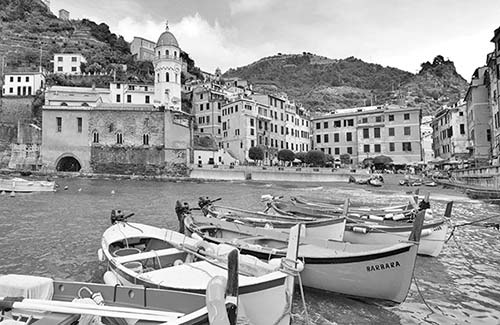
Proud of their Vernazzan heritage, the town’s 500 residents like to brag: “Vernazza is locally owned. Portofino has sold out.” Fearing change, keep-Vernazza-small proponents stopped the construction of a major road into the town and region. Families are tight and go back centuries; you’ll notice certain surnames (such as Basso and Moggia) everywhere. In the winter, the population shrinks, as many people return to more-comfortable big-city apartments to spend the money they earned during the tourist season.
During the day in season the tiny harborfront and one main street are clogged with gawking group excursions. But early and late Vernazza is the cool and content domain of locals...and travelers who are lucky enough to call the town home for a couple of nights.
Join (or sit on a bench and watch) the locals devoting their leisure time to taking part in the passeggiata—strolling lazily together up and down the main street, doing vasche (laps). Explore the characteristic alleys called caruggi. Learn—and live—the phrase “la vita pigra di Vernazza” (the lazy life of Vernazza).
At the train station, you can get answers to basic questions at the gift shop/park office (daily 8:00-20:00, closed in winter, tel. 0187-812-533, WCs just down the track, see here for baggage storage).
By Train: Vernazza’s train station is only about three train cars long, but the trains themselves are much longer, so most cars come to a stop in a long, dimly lit tunnel. Get out anyway, and walk through the tunnel—heading for the light—to reach the station. From there the main street flows through town right down to the harbor. If you’re sleeping here, many locals who rent rooms will meet you at the station and walk you to your place (call ahead to tell them which train you’re on).
By Car: Don’t drive to Vernazza. Roads to Vernazza are in terrible shape, and parking is strictly limited. If you’re coming from the north, park in Levanto. If arriving from the south, park in La Spezia. From either town, hop on the train.
Market: Vernazza’s skimpy business community is augmented Tuesday mornings (8:00-13:00), when a meager gang of cars and trucks pulls into town for a tailgate market. Eros is often among the vendors; his family has sold flowers here for years (and he’s also an amazing opera singer).
Baggage Storage: You can pay to leave your bags at the train station TI/gift shop (daily 9:00-19:00, closed in winter). The staff will also happily haul your luggage between the train station and your accommodations (€4/piece).
Laundry: A small self-serve launderette is at the top of town next to the post office (daily 9:00-22:00).
Booking Agency: Cinque Terre Riviera, run by Miriana, books vacation rentals in the Cinque Terre towns and La Spezia. They also sell tickets for Vernazza’s summer opera and can arrange transportation, cooking classes, and weddings (Via Roma 24, tel. 0187-812-123, mobile 340-794-7358, www.cinqueterreriviera.com, info@cinqueterreriviera.com).
Massage: Kate Allen offers a relaxing fusion of aromatic/Swedish/holistic massage and reflexology in her studio in the center across from the pharmacy (tel. 0187-812-537, mobile 333-568-4653, www.vernazzamassage5terre.com, katarinaallen@hotmail.com).
This self-guided walk gives you a quick overview of the town and starts out on its breakwater.
• From the train station, just walk downhill and all the way out onto the breakwater. (Ropes are put up to protect gawky tourists from dangerous waves.) Find a comfortable and safe place to sit and get to know Vernazza.
Before the 11th century, pirates made this coast uninhabitable, so the first Vernazzans lived in the hills above. The earliest references call the town “Fortress Vernazza.” Its towers, fortified walls, and hillside terracing date mostly from the 12th through 15th century. That’s when the threat of pirates subsided and people felt comfortable coming out of the hills. Vernazza allied itself with the Republic of Genoa, a maritime power of the day. The big red central building facing the harbor was once the site where Genoan warships were built (12th century).
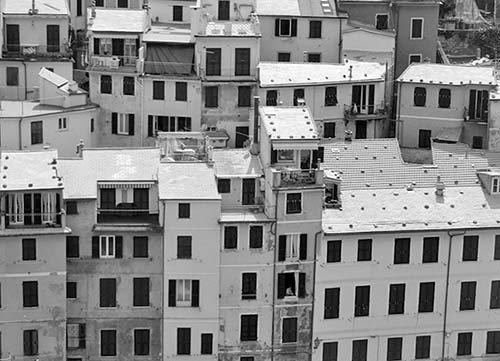
In the Middle Ages, there was no beach or square. The water went right up to the buildings, where boats would tie up, Venetian-style. Imagine what Vernazza looked like in those days, when it was the biggest and richest of the Cinque Terre towns. Buildings had a water gate (facing today’s square) and a front door on the higher inland side. There was no pastel plaster—just fine stonework (traces of which survive above Trattoria del Capitano). The town, hiding behind its little bluff, was camouflaged by its gray stonework—certainly not gaily painted to attract the eyes of marauding pirates. But apart from the added paint and plaster, the general shape and size of the town has changed little in five centuries. Survey the windows and notice inhabitants quietly gazing back. (At least they did before Airbnb changed the economic environment of touristy towns like Vernazza, driving prices up and locals away from the most charming spots.)
Vernazza has two halves. Sciuiu (Vernazzan dialect for “flowery”) is the sunny side on the left, and luvegu (dank) is the shady side on the right. Houses below the castle were connected by an interior arcade—ideal for fleeing attacks.
The “Ligurian pastel” colors of the buildings are regulated by the regional government’s commissioner of good taste. The square before you is known for some of the area’s finest restaurants.
While the town has 1,500 residents in summer, only 500 stay here through the winter. Vernazza has accommodations for about that many tourists.
The small, round tower above the red building is another part of the city fortifications, reminding us of the town’s importance in the Middle Ages. Back then, Genoa’s enemies (rival maritime republics, especially Pisa) were Vernazza’s enemies. That tower recalls a time when the town was fortified by a stone wall.
Vineyards fill the mountainside beyond the town. Notice the many terraces. For six centuries, the economy was based on wine and olive oil. Then came the 1980s—and the tourists. Locals turned to tourism to make a living, and stopped tending the land and vineyards.
Although many locals still maintain their small plots and proudly serve their family wines, the patchwork of vineyards is atomized and complex because of inheritance traditions. Historically, families divided their land among their children. Parents wanted each child to receive good land, though some lots were “kissed by the sun” while others were shady. Lots were split into increasingly tiny, unviable pieces, and many were eventually abandoned. The vineyards once stretched as high as you can see, but since fewer people sweat in the fields these days, the most distant terraces have gone wild again.
Vernazza’s Ligurian Gothic church, built with black stones quarried from Punta Mesco (the distant point between Monterosso and Levanto), dates from 1318. Note the gray stone (on the left) that marks the church’s 16th-century expansion. The gray-and-red house above the spire is the elementary school (about 25 children attend). Older students go to the “big city,” La Spezia. The red building on the hill to the right of the schoolhouse, a former monastery, is now the City Hall. Vernazza and neighboring Corniglia function as one community. Through most of the 1990s, the local government was Communist. In 1999, residents elected a coalition of many parties working to rise above ideologies and simply make Vernazza a better place. That practical notion of government continues here today.
Finally, on the top of the hill, with the best view of all, is the town cemetery. It’s only fair that hardworking Vernazzans—who spend their lives climbing up and down and up and down and up and down the hillsides that hem in their little town—are rewarded with a world-class view from their eternal resting place.
• Look high on your right to the castle.
The castle, which is now just stones and a grassy park with super views, still guards the town (€1.50, daily 10:00-20:00, summer until 21:00, closed Nov-March; from harbor, take stairs by Trattoria Gianni and follow Ristorante al Castello signs, the tower is a few steps beyond). This was the town’s watchtower back in pirate days.
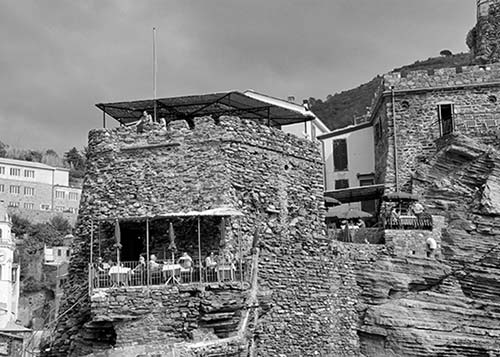
The squat tower below the castle, overlooking the water, Ristorante Belforte, is a great spot for a glass of wine or a meal. From the breakwater, you could follow the rope to the restaurant and pop inside, past an actual submarine door. A photo of a major storm showing the entire tower under a wave (not uncommon in the winter) hangs near the bar.
In a moderate storm, you’d get soaked where you’re sitting, as waves routinely crash over the molo (breakwater, built in 1972). Waves can rearrange the huge rocks—depositing them from the breakwater onto the piazza and its benches. Freak waves have even washed away tourists squinting excitedly into their cameras. (I’ve seen it happen.) In 2007, an American woman was swept away and killed by a rogue wave.
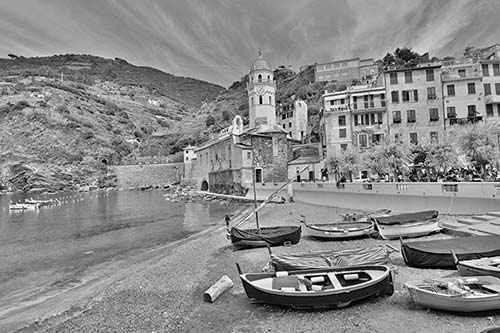
The train line (across the harbor) was constructed in 1874 to tie together a newly united Italy, linking Turin and Genoa with Rome. A second line (hidden in a tunnel at this point) was built in the 1920s. The yellow building alongside the tracks was Vernazza’s first train station. Along the wall behind the tracks, you can see the four bricked-up alcoves where people once waited for trains. The wonderful concrete sunbathing strip (and place for late-night privacy) laid below the tracks along the rocks makes for a fun little stroll. (Buoys along the shoreline establish a boat-free swimming zone.)
Vernazza’s fishing fleet is down to just a few boats with net spools, but Vernazzans are still more likely to own a boat than a car. Boats are moored on buoys, except in winter or when the red storm flag indicates rough seas (see the pole at the start of the breakwater). When the red flag flies, boat owners are permitted to pull them up onto the square—which is usually reserved for restaurant tables. In the 1970s, tiny Vernazza had one of Italy’s top water polo teams, and the harbor was their “pool.” Later, when the league required a real pool, Vernazza dropped out.
• Stroll from the breakwater to the harbor square. Look for a small historic stone just before the narrow stairway on the right.
Vernazza, with the Cinque Terre’s only natural harbor, was established as the sole place boats could pick up the fine local wine. The two-foot-high square stone at the foot of the stairs is marked Sasso del Sego (stone of tallow). Workers crushed animal flesh and fat in its basin to make tallow, which drained out from the tiny hole below. The tallow was then used to waterproof boats or wine barrels.
Stonework is the soul of the region. Take some time to appreciate the medieval stonework and chestnut timbers of the restaurant interiors facing the harbor. From here steps lead to your right up to the castle.
Towns along this coast were designed as what’s called a “Ligurian Palazzata”—an interlinked series of buildings intended to provide protection from seaborne attacks. Vernazza’s harborfront retains its thousand-year-old “stockade” of buildings, connected with tiny and easy-to-defend staircases leading from the vulnerable harbor higher into the community.
• Cross to the church side of the harbor, and peek into the tiny street leading away from the water with its commotion of arches. Vernazza’s most characteristic side streets (caruggi) lead up from here. Another narrow set of stairs marks the beginning of the trail that leads up, up, up to the quintessential view of Vernazza—and, eventually, on to Monterosso (my favorite two-hour hike in the region).
Vernazza’s harborfront church sits on the tiny piazza, decorated with a river-rock mosaic. This popular hangout spot is where the town’s older ladies soak up the last bit of sun, and kids enjoy a patch of level ball field. The church, nestled awkwardly into the rocks, is unusual for its east-facing (rather than the standard west-facing) entryway. With relative peace and prosperity in the 16th century, the townspeople doubled the size of their church, extending it west over what was the little piazza that faced it.
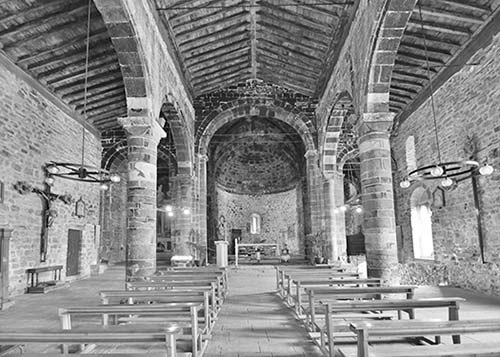
Enter under a statue of St. Margaret, patron saint of Vernazza, and climb the steps into the nave. The space was originally dark (with just the upper slit windows) before the bigger gothic window were added with the 16th-century expansion. The lighter pillars in the back mark the extension. Three historic portable crosses hanging on the walls are carried through town during religious processions. These are replicas of crosses that (locals like to believe) Vernazzan ships once carried on crusades to the Holy Land. The town priest, Don Giovanni, is popular—he stopped the church bells from ringing through the night (light sleepers rejoiced).
• Now walk back across the harbor square and head left into town. After the lane opens up on the right, hike through the cave to the new beach.
This is where the town’s stream used to hit the sea back in the 1970s. Older locals remember frolicking on a beach here when they were kids, but the constant, churning surf eventually eroded it all the way back to the cliff. When the 2011 flood hit, it blew out the passageway and deposited landslide material here from the hills above. In the flood’s aftermath, Vernazza’s main drag and harbor were filled with mud and silt. Workers used the debris to fill in even more of this beach. But as time goes on, the forces of nature are once again taking it away.
• Back on the main drag, continue uphill to...
You’re now strolling through Vernazza’s “commercial center”: souvenir shops, wine shops, the Blue Marlin Bar (a good nightspot), and so on. The small stone chapel with iron grillwork over the window (on the right) is the tiny Chapel of Santa Marta, where Mass is celebrated on special Sundays. You’ll walk by a gelateria, bakery, pharmacy, grocery, and another gelateria. There are plenty of fun and cheap food-to-go options here. While it’s easy to get distracted by all the tourists, try to see through them to notice locals going about their business.
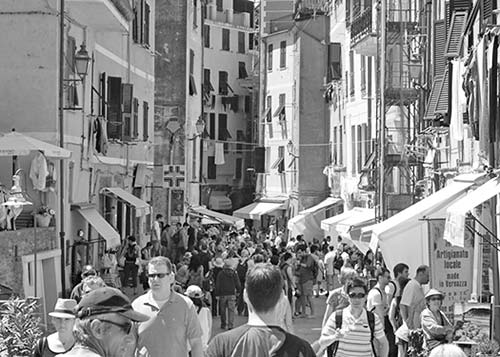
On the right, just before the train tracks, study the big poster, which shows photos of the 2011 flood (alluvione) and the shops it devastated. “The 25th of October” is a day that will live forever in this town’s lore. Vernazza is built around one street—basically a lid over the stream in its ravine. On that fateful day, the surrounding hills acted like a funnel, directing flash-flood waters right through the middle of town. Four townspeople lost their lives. Imagine this street from here to the harbor buried under 13 feet of mud. Every shop, restaurant, and hotel on the main drag had to be rewired, replumbed, and re-equipped.
The second set of train tracks (nearer the harbor) was renovated to lessen disruptive noise. At the base of the stairs a handy monitor displays up-to-the-minute schedules for arriving and departing trains (including any running late—ritardo). The walls under the tracks serve as a sort of community information center. Just above the tracks (to the right), the town provides limited space for advertising for political parties (but only during the weeks leading up to an election).
• Hike a few steps under and above the tracks to the little square.
The millstones set on the square are a reminder that the town stream (which goes underground here and which you’ve been walking over ever since leaving the harbor area) once powered Vernazza’s water mill. (You can still see its tiny “river” if you follow this road up a few steps.) Until the 1950s, the river ran openly through the center of town. Old-timers recall the days before the breakwater, when the river cascaded down, charming bridges spanned the ravine, and the surf sent waves rolling up Vernazza’s main drag.
Corralling this stream under the modern street, and forcing it to take a hard turn here, contributed to the damage caused by the 2011 flood. After the flood, Swiss engineers redesigned the drainage system, so any future floods will be less destructive. They also installed nets above the town to protect it from landslides.
On the wall ahead at the bend in the road, notice the World Wars Monument—dedicated to those killed in World Wars I and II. Not a family in Vernazza was spared. Listed on the left are soldiers morti in combattimento who died in World War I; on the right is the WWII section. Some were deported to Germania; others—labeled Part (for partigiani, or partisans)—were killed while fighting against Mussolini.
The path to Corniglia begins from here (behind and above the monument). Even if you don’t plan to hike its entire length, you don’t have to go far to find fine views over Vernazza’s stony peninsula.
• To see a more workaday part of Vernazza, head a couple of minutes uphill from here to the...
First you’ll pass the ambulance barn (on the left, at #7, with big brown garage doors and a croce verde Vernazza sign), where a group of volunteers is always on call for a dash to the hospital, 40 minutes away in La Spezia. Farther up, you’ll come to a functional strip of modern apartment blocks facing the river. In this practical zone—the only place in town that allows cars—are a bank, the post office, a launderette, and the popular bar/café called Il Pirata delle Cinque Terre. The parking lot fills a square called Fontana Vecchia, named for an “old fountain” that’s so old, it’s long gone. Shuttle buses run from here to hamlets and sanctuaries in the hills above. (Check the schedule post if you want to enjoy the scenic shuttle bus up to the sanctuary and hike back into town—described below.)
Looming over this neighborhood is a terraced hill capped by the town cemetery (a 20-minute steep hike from here), and a 30-minute climb beyond that, the town’s Madonna di Reggio sanctuary.
For a rundown of ambitious hikes from Vernazza—including the main coastal trail to Corniglia and to Monterosso—see here. Here are some alternatives closer to town.
From Vernazza, you can hike in either direction for classic photo ops. Both hikes are steeply, but briefly, uphill (about 10 minutes to the best views and park ticket checkpoints).
For the best light in the morning, follow the trail toward Corniglia; you’ll twist up through vineyards to earn great views down over the stony back side of Vernazza’s peninsula, with its round castle tower poking up and a Monterosso backdrop. The best views are from just before the national park ticket checkpoint. If you need a rewarding rest up here, Bar la Torre offers drinks with a grand view.
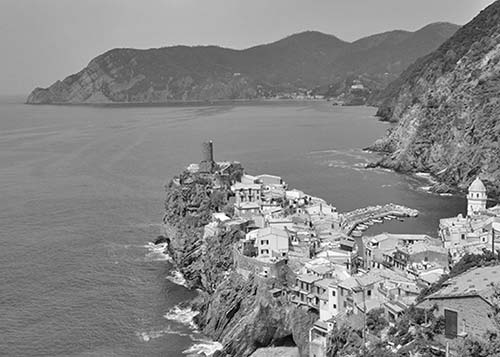
The trail toward Monterosso has the best light in the evening. From the harbor, you’ll hike up through the steep and narrow alleys before popping out on the trail above town. Follow this around the bluff, enjoying better and better views of Vernazza’s tidy pastel harbor. The views are fine before the ticket booth, but even better after—if you don’t want to buy a Cinque Terre park card, you can hike up here in the evening, after the park officially closes (typically around 19:00).
Hike to the Cemetery: To hike up to Vernazza’s sweet little cemetery, find the steep lane from the ravine at the top of town. From here, it’s a 20-minute hike to the top. You’ll find a peaceful world of lovingly tended family graves with stunning views over the Cinque Terre. Imagine the entire village sadly trudging up here during funerals. The cemetery is peaceful and evocative at sunset, when the fading light touches each crypt.
For a cheap and scenic joyride (50 minutes, €1.50), with a chance to chat about the region with friendly, English-speaking Mirco, Pietro, or Graziella, ride the ATC shuttle bus, which loops about five times a day from the top of Vernazza to sanctuaries and hamlets high in the hills—including the San Bernardino sanctuary and Madonna di Reggio sanctuary—and back again (for times, check schedule posted at the bus stop, ask at the TI, or check online at www.atcesercizio.it). Look for the bus to Madonna di Reggio via Fornacchi.
Joyride: The bus ride is absolutely stunning. It can be crowded, but most hikers get off at the first stop (San Bernardino). I prefer either to stay on for three-quarters of the loop (to Madonna di Reggio, then hike back to Vernazza from there; see below), or all the way to complete the scenic circle.
As you ride, you’ll see tiny settlements that predate the Cinque Terre villages, built back when people were afraid to live on the coast for fear of pirates. These hamlets and their terraces go back a thousand years. You’ll switchback past chestnut trees, which historically provided wood for fuel and lumber, and chestnuts, which were ground to make a kind of flour in a land with no grain.
Hiking Down from Madonna di Reggio: For a delightful and easy (if steep) half-hour hike into Vernazza, ask the driver to let you out at the stop for Santuario Nostra Signora di Reggio.
First, walk two minutes below the bus stop to the sanctuary, which dates from 1248 and has a Romanesque facade. Inside the church, interesting votives (little ships and paintings of ships in angry seas given as tokens of thanks) fill the rear corner—gifts from sailors who survived storms and soldiers who survived wars. A volunteer staffs the church selling coffee, water, and snacks.
From here signs direct you to trail #508—the historic original trail down to Vernazza. You’ll be walking on thousand-year-old cobbles through abandoned olive groves and past the Stations of the Cross, which have inspired generations of processions trudging up from Vernazza. You may see a parked trenino, one of about 40 monorail mini-trains in the area that help farmers get their grapes from distant fields to their trucks.
You’ll descend through the cemetery, then either take the stairs down to the train station, or continue to the left down the lane to the square called Fontana Vecchia, where you caught the shuttle bus.
The harbor’s sandy cove has sunning rocks and showers by the breakwater. The sunbathing lane directly under the church has a shower. A ladder on the seaside of the breakwater aids deep-water swimmers. And, while it’s getting smaller and rockier each year, Vernazza’s “new beach” can be accessed through a hole halfway along the town’s main drag.
In addition to the regularly scheduled big boats that depart from Vernazza’s harbor (see here), hiring your own boat can be handy for intertown transport. It’s also a great way to escape the crowds and get a different angle on Cinque Terre splendor. From Vernazza, figure around €50 one-way to boat to the other towns (for up to six passengers in an outboard). Or hire a boat for a one-hour sightseeing cruise of the entire Cinque Terre (about €150); one popular stop is the tiny acqua pendente (waterfall) cove between Vernazza and Monterosso, which locals call their laguna blu.
Some boat captains offer evening aperitivo cruises on a per-person basis. At Vernazza’s breakwater you’ll find Nord Est, run by Vincenzo (with help from Cesare), the best-established option (mobile 338-700-0436, info@nordest-vernazza.com). Vernazza Water Taxi, run by Pietro, is another choice (mobile 338-911-3869, info@vernazzawatertaxi.it).
Vernazza Wine Experience hides out at the top of town just under the castle. Run by Alessandro, a sommelier, it’s romantic, with mellow music and a hardwood, ship-deck ambience. Tastings start at €15/person and can be matched up with meat-and-cheese small plates. While the bill can add up, the quality is excellent and the view is unforgettable (cash only, daily 17:00-20:00, hike from harborfront and turn left before castle, Via S. Giovanni Battista 31, tel. 331-343-3801). For tastings without the view or the climb, drop by his place behind the train station called Cinque Sensi (similar prices, Via Roma 71, daily 12:00-24:00).
A favorite Cinque Terre evening memory for many is Vernazza’s summer opera. A big-name maestro from Lucca brings talented singers to town twice weekly. Performances (two singers and a piano) fill the small oratory, a medieval building with fine acoustics that was beautifully restored for this purpose (just up the steps from the church). Performances begin at 19:00 and last just over an hour—strategically timed to squeeze between a late-afternoon aperitivo on the harbor and a 20:30 dinner reservation (€18 in advance, €20 at the door, May-Oct Wed and Fri at 19:00, book tickets at Cinque Terre Riviera office at #24 on the main street, tel. 0187-812-123, info@cinqueterreriviera.com).
Vernazza generally shuts down pretty early. The town’s nightlife centers on the bars on its waterfront piazza, which is the place to “see and be seen.” Young restaurant workers work hard throughout the tourist season, but they let loose after-hours and enjoy connecting with international visitors in the town’s few nightspots (which are required to close by midnight). For a more genteel option, consider an opera performance or a wine tasting (both described above). Or in the cool, calm evening, sit on the town’s breakwater with a glass of wine and watch the phosphorescence in the waves.
The Blue Marlin Bar dominates the late-night scene with a mix of locals and tourists, good drinks, and an open piano. If you play piano, you’re welcome to join in. Ananasso Bar offers early-evening happy-hour fun and cocktails (aperitivi) that both locals and visitors enjoy. Its harborfront tables get the last sunshine of the day. For more on these bars, see their listings under “Eating in Vernazza,” later.
Vernazza lacks any real hotels, and almost all of my listings are affittacamere (private rooms for rent). I favor hosts who rent multiple rooms and have a proven track record of good communication (they speak just enough English, have email, and are reliable). Airbnb is really big in Vernazza.
Most places accept only cash, promise free Wi-Fi (often spotty), and don’t include breakfast unless noted. Some have killer views, and some come with lots of stairs. Expect noise at night: Trains tearing through, church bells (after 7:00 and before 22:00), crashing waves, cars in the upper town. Come to think of it, just pack earplugs.
While a few places have all their beds in one building, most have rooms scattered all over town. Better-organized outfits have an informal reception desk (sometimes at a restaurant or other business) where you can check in. But many places have no reception at all. (The Vernazza map in this book shows only the places that have a fixed address or reception office; if I mention “reception,” you’ll check in there.)
If you overnight here, communicate your arrival time to your host and get clear instructions on where to meet and pick up the keys. They’ll usually offer to meet you at the train station if they know when you’re coming.
The Cinque Terre Riviera agency, based in Vernazza, rents rooms here and throughout the region (www.cinqueterreriviera.com; see here.
$$$$ La Malà is the town’s jet-setter pad. Four crisp, pristine white rooms boast fancy-hotel-type extras and a shared seaview terrace. It’s a climb—way up to the top of town—but they’ll carry your bags to and from the station. Book early; this place fills up quickly (includes breakfast at a bar, family rooms, air-con, mobile 334-287-5718, www.lamala.it, info@lamala.it, charming Giamba and his mama, Armanda). They also rent two rooms at the simpler $ “Armanda’s Room” nearby—a great value, since you get Giamba’s attention to detail and amenities without paying for a big view (includes simple breakfast, air-con).
$$$$ Vernazza sul Mare rents two view, luxury apartments (one- and two-bedroom, sleeping 4-6) that overlook the sea and town from private, spacious terraces. The light-filled, airy units come with sea breezes and a crashing-waves soundtrack. These are great for families and can be connected for larger groups (both with air-con, fully equipped kitchens, climb steps up to Via Carattino 12, mobile 345-363-6118, www.vernazzasulmare.com, info@vernazzasulmare.com, run by helpful American-Italian Ruth and her family).
$$$ Nicolina Rooms consists of seven rooms and one apartment in three different buildings. Two cheaper rooms are in the center over the pharmacy, up a few steep steps; another, pricier studio with a terrace is on a twisty lane above the harbor; and four more rooms are in a building beyond the church, with great views and church bells (all include breakfast, Piazza Marconi 29—check in at Pizzeria Vulnetia, tel. 0187-821-193, mobile 333-842-6879, www.camerenicolina.it, info@camerenicolina.it).
$$$ La Marina Rooms is run by hardworking Christian, who speaks English and happily meets guests at the station to carry bags. There are five well-tended, airy, and renovated units, most high above the main street: One single works as a (very) tight double, and three doubles have fine oceanview terraces; he also has two apartments—one with terrace and sea views, and the other on the harborfront square (rooms have fridges, mobile 338-476-7472, www.lamarinarooms.com, mapcri@yahoo.it).
$$$ Monica Lercari rents several rooms with modern comforts, perched at the top of town (more for seaview terrace, includes breakfast, air-con, tel. 0187-812-296, mobile 320-025-4515, monimarimax@gmail.com). Monica and her husband, Massimo, run the recommended Ristorante al Castello, in the old castle tower overlooking town.
$$ Francamaria and her husband Andrea rent 10 sharp, comfortable, and creatively renovated rooms. Their reception desk is on the harbor square (on the ground floor at Piazza Marconi 30), but the rooms they manage are all over town (family rooms, some with air-con, mobile 328-711-9728, www.francamaria.com, francamariareservation@gmail.com). They also rent a room in Manarola.
$$ Emanuela Colombo rents a spacious and classy room on the harbor square, and a molto chic split-level apartment on a quiet side street (sleeps up to four, reception at Via Roma 27, tel. 339-834-2486, www.vacanzemanuela.it, manucap64@libero.it).
$$ Vernazza Rooms, run by Massimo, rents 14 rooms: Four are above the Blue Marlin Bar looking down on the main street, and seven are a steep climb higher up, just under the City Hall (big family apartments, a few with air-con and others with fans, fridges in all rooms, arrange check-in time in advance and meet your host at Via del Santo 9, mobile 351-918-3164, www.vernazzarooms.com, info@vernazzarooms.com).
$$ Lovely Rosa Vitali rents a four-person apartment with a full kitchen; it’s across from the pharmacy overlooking the main street—and beyond the train noise (ring bell at Via Visconti 10—just before the tobacco shop near Piazza Marconi, tel. 0187-821-181, mobile 340-267-5009, www.rosacamere.it, rosa.vitali@libero.it).
$$ Maria Capellini rents two simple, clean rooms that face each other across the harbor; one is at ground level just steps from the beach and with a view; the other looks over a skinny street (fridge, fans, mobile 338-436-3411, www.mariacapellini.com [URL inactive], mariacapellini@hotmail.it, kindly Maria and Giacomo).
$$ Martina Callo’s four old-fashioned, spartan rooms overlook the harbor square; they’re up plenty of steps near the silent-at-night church tower. While the rooms are simple, guests pay for and appreciate the views (family rooms, cheaper nonview room, air-con, ring bell at Piazza Marconi 26, tel. 0187-812-365, mobile 329-435-5344, www.roomartina.it, roomartina@roomartina.it), Martina and her father, Giuseppe.
$ Rooms Francesca’s offers one tidy room with sea views and air-con, and a two-bedroom apartment with fans. Both hide out in the steep streets just below City Hall (check in at Enoteca Sciacchetrà at Via Roma 19, tel. 0187-821-112, mobile 339-101-2962, www.5terre-vernazza.it, moggia.franco@libero.it; Francesca, Franco, and Sabine).
$ Ivo’s Camere rents two tight but well-appointed rooms several flights of stairs above the main street (air-con, Via Roma 6, mobile 333-477-5521, www.ivocamere.com, post@ivocamere.com).
$ Albergo Barbara rents nine tidy, Ikea-chic top-floor rooms overlooking the square with an attic communal lounge. Most have small windows and small views; view rooms are more expensive. It’s a good value in a nice location, run by Alessio and Alberto (cheaper rooms with shared bathroom, lots of stairs, reserve online with credit card but pay cash, Piazza Marconi 30, tel. 0187-812-398, www.albergobarbara.it, info@albergobarbara.it).
$ Memo Rooms rents two clean and spacious rooms overlooking the main street, in what feels like a miniature hotel. Enrica will meet you if you call upon arrival (Via Roma 15, try Enrica’s mobile first at 338-285-2385, otherwise call 0187-812-360, www.memorooms.com, info@memorooms.com).
If my recommendations above are full, try these:
$$ Capitano Rooms (3 rooms and 1 apartment several flights of stairs above main drag, fans; ask for Julia, Paolo, Edoardo, or Barbara at Trattoria del Capitano restaurant on main square at Piazza Marconi 21, tel. 0187-812-201, www.tavernavernazza.com, info@tavernavernazza.com); $ Eva’s Rooms (2 rooms on main street, air-con, train noise, 2-night minimum, call ahead to arrange meeting place, tel. 334-798-6500, www.evasrooms.it, evasrooms@yahoo.it); $$$ Rooms Elisabetta (2 tight, recently renovated, casually run rooms and 1 apartment at the tip-top of town with Vernazza’s ultimate 360-degree roof terrace—come here for the views; fans, partway up Corniglia path at Via Carattino 62, mobile 347-451-1834, www.elisabettacarro.com, carroelisabetta@hotmail.com, Elisabetta); $$ Manuela Moggia (3 apartments and 2 rooms, more for kitchen or view, behind train station at Via Gavino 22 and on main square, tel. 0187-812-397, mobile 333-413-6374, www.manuela-vernazza.com, info@manuela-vernazza.com).
Above the Train Station: $$$$ Casa Cato offers six modern, tight but well-outfitted rooms, some with private balconies and all with access to an inviting shared terrace overlooking the sea and town (RS%, air-con, fridge, expect some train noise, mobile 334-123-8579, www.casacatocinqueterre.com, info@casacatocinqueterre.com, Lisa). They also rent an apartment in the center of town.
$$$ Giuliano Basso’s four carefully crafted, well-appointed rooms form a cozy little compound with a common lounge and view terrace, straddling a ravine among orange trees. Giuliano—the town’s last stone-layer—proudly built the place himself. To reach this quiet retreat on the green hillside just above town and the train station, you’ll climb partway up the Corniglia footpath (2 rooms have air-con, more train noise than others; follow the main road up above the station, take the ramp up toward Corniglia just before Pensione Sorriso, follow the path, and watch for a sharp left turn—or ask Giuliano to meet you at the station; mobile 333-341-4792, www.cameregiuliano.com, giuliano@cdh.it).
In the Ravine at the Top of Town: These practical options are a five-minute, gently uphill stroll behind the train station. While this functional zone is less atmospheric, it is easy to access (with fewer steep stairs). There’s no train or church-bell noise—the constant soundtrack is Vernazza’s gurgling river—but there can be traffic noise.
$$ Camere Fontanavecchia, run by Annamaria, is the best choice here, with eight bright and cheery rooms (three with terraces) overlooking the ravine and its rushing river (Via Gavino 15, tel. 0187-821-130, mobile 333-454-9371, www.cinqueterrecamere.com, m.annamaria@libero.it). She also rents an apartment.
$$ Tonino Basso/La Perla, spread over two floors, has 10 overpriced rooms in a drab, elevator-equipped, modern apartment block. La Perla’s rooms feel fresher (air-con, fridge, Via Gavino 34, mobile 339-761-1651, www.toninobasso.com and www.laperladelle5terre.it, Alessandra).
$ La Rosa dei Venti (“The Compass Rose”), run by Giuliana Basso, houses three airy, good-value rooms in her childhood home, on the third floor of an apartment building (call to arrange meeting time, air-con, Via Gavino 19, mobile 333-762-4679, www.larosadeiventi-vernazza.it, info@larosadeiventi-vernazza.it).
$$$ Gianni Franzi, a busy restaurant on the harbor square, runs the closest thing to a big hotel in Vernazza. There are 25 small rooms scattered across three buildings a hundred tight, winding stairs above the harbor square. Some rooms (including a few cheaper ones with shared bathrooms) are funky and decorated à la shipwreck, with tiny balconies and grand sea views. The comfy, newer rooms lack views. All guests have access to a super-scenic cliff-hanging garden and panoramic terrace (where breakfast is served in season). Steely Marisa requires check-in before 16:00 or a phone call to explain when you’re coming. Emanuele, Simona, and staff speak enough English (RS%, closed Jan-Feb, Piazza Marconi 1, tel. 0187-812-228, mobile 393-9008-155, www.giannifranzi.it, info@giannifranzi.it). Pick up your keys at the restaurant, but on Wed, when the restaurant is closed, call ahead to make other arrangements.
B&Bs in Vernazza provide B but no B. That’s kind of a blessing, as Vernazza has plenty of options, from full bacon and eggs (Blue Marlin and Capitano), to a Sicilian bakery of fresh pastries (Il Pirata), to coffee and a sweet roll on the harborfront (Ananasso), to any number of bakeries selling sweet and savory options to go. For a full breakfast, you’ll pay €12-15. Here are your main options from the top of town to the harbor (in that order). Most of these places are also recommended in my lunch and dinner listings.
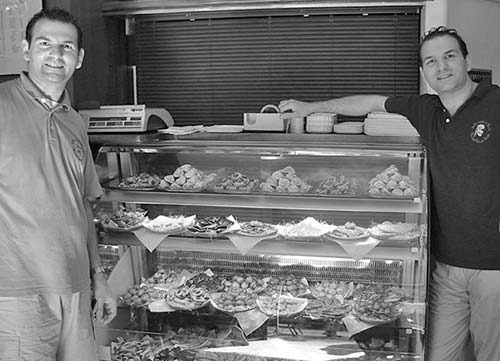
$ Il Pirata delle Cinque Terre, located in the workaday zone at the parking lot at the top of town, is playful, efficient, comfortable, and serves tasty breakfast bruschetta, frittatas, and an array of fresh pastries. The fun service of the dynamic duo Gianluca and Massimo (hardworking Sicilian twins, a.k.a. the Cannoli brothers) makes up for the lack of a view. They pride themselves on not serving bacon and eggs, since “this is Italy.” While the atmosphere feels more like suburban Milan, it has charisma (daily 7:00-24:00, also serves lunch and dinner—see later, Via Gavino 36, tel. 0187-812-047).
$$ Blue Marlin Bar (midtown, just below the train station) serves a good array of clearly priced à la carte breakfast items (Italian breakfast from 7:30, eggs and bacon 8:30-11:30). If you’re awaiting a train and the platform isn’t crowded, it’s pleasant to have a seat at Blue Marlin’s outdoor seating with a prepaid drink in view of the tracks (Thu-Tue 7:30-23:00, closed Wed).
$ Lunch Box is the hardworking new kid on the block, with lots of hot options and a fun little perch for a couple of tables overlooking the main drag (daily 7:00-22:00, also serves lunch and dinner—see later, Via Roma 34, mobile 338-908-2841, Stefano).
$$ Trattoria del Capitano offers outdoor seating on the harbor, as well as cozy spots inside the restaurant and a full menu (Wed-Mon 8:00-22:00, closed Tue except in Aug, on Piazza Marconi, tel. 0187-812-201, hardworking Paolo and Barbara speak English).
$$ Ananasso Bar has a youthful energy, a great location right on the harbor, and a skimpy Italian breakfast menu (toasted panini, pastries, Muesli with yogurt, and cappuccino). You can eat a bit cheaper at the bar (you’re welcome to picnic on the nearby bench or seawall rocks with a Mediterranean view) or enjoy the best-situated tables in town (Fri-Wed 8:00-late, closed Thu, on Piazza Marconi).
Picnic Breakfast: Drop by one of Vernazza’s many little bakeries, focaccia shops, or grocery stores to assemble a breakfast to eat on the breakwater. Top it off with a coffee in a nearby bar.
Vernazza’s restaurants work hard to win your business. Wander around at about 20:00 and compare the ambience. If you dine in Vernazza but are staying in another town, check train schedules before sitting down to eat, as evening trains run less frequently, with gaps in the schedule. To get an outdoor table on summer weekends, reserve ahead. Harborside restaurants and bars are easygoing. You’re welcome to grab a cup of coffee or glass of wine and disappear somewhere on the breakwater, returning your glass when you’re done. You’ve got lots of options and prices are competitive, with €11-15 pastas and €15-25 secondi.
$$$ Gianni Franzi is an old standby for well-prepared seafood and pastas. Emanuele, Nicolas, and their crew provide steady, reliable, and friendly service. The outdoor seating is partially tucked under an arcade, while the indoor setting is big, open, and classy (check their menù cucina tipica Vernazza, Thu-Tue 12:00-15:00 & 19:00-22:00, closed Wed except in Aug, tel. 0187-812-228).
$$$ Trattoria del Capitano feels unpretentious and serves a short menu of straightforward local dishes, including spaghetti allo scoglio—pasta entangled with various types of seafood (for hours and location, see “Breakfast,” earlier).
$$$ Ristorante Pizzeria Vulnetia has a nautical, jovial atmosphere. It serves regional specialties; but unlike the others, it also dishes up thin-crust pizzas—making this a good choice for a group with differing tastes, those on a budget, and families (Tue-Sun 12:00-22:00, closed Mon, Piazza Marconi 29, tel. 0187-821-193, Tullio and Federica).
$$ Pizzeria Baia Saracena (“Saracen Bay”) serves forgettable pizza and pastas out on the breakwater. Eat here not for high cuisine, but for a memorable atmosphere at reasonable prices (Sat-Thu 11:30-22:00, closed Fri, tel. 0187-812-113, Luca and Andrea).
$$$$ Gambero Rosso rounds out the options on the harbor. Long the top restaurant in town, today it’s lost its edge (it was sold to a big-city restaurateur who runs it from afar). Still, it’s reliably good, and has a fine interior and great outdoor tables (Fri-Wed 12:00-15:00 & 19:00-22:00, closed Thu and Dec-Feb, Piazza Marconi 7, tel. 0187-812-265).
$$$$ Ristorante Belforte is a cut above the rest, serving a fine blend of traditional and creative cuisine, fishy spaghetti alla Bruno, trofie al pesto (hand-rolled noodles with pesto), and classic antipasto misto di pesce—an assortment of fish (€24/person for 5 plates; 2-person minimum). From the breakwater, a rope leads up from the harbor to a web of tables embedded in four levels of the old castle. While their indoor seating is great, for the ultimate seaside perch, reserve a table on the terrazza con vista (view terrace) or request the “lovers’ table” on its own little terrace. Most of Belforte’s seating is outdoors—if the weather’s bad, the interior can get crowded. Late in the evening, Andrea cranks up the fun (Wed-Mon 12:00-15:00 & 19:00-22:00, closed Tue and Nov-March, tel. 0187-812-222, Michela).
$$$ Ristorante al Castello—a bit less expensive and a bit more homey than the others—is run by gracious and English-speaking Monica, her husband Massimo, and their sometimes-gruff staff. Hike high above town to just below the castle for commanding views. Reserve one of the dozen romantic cliffside seaview tables for two—some of the tables snake around the castle, where you’ll feel like you’re eating all alone with the Mediterranean. Monica offers a free sciacchetrà or limoncello with biscotti with this book by request (Thu–Tue 12:00–15:00 & 19:00–22:00, closed Wed and Nov–April, tel. 0187-812-296).
Several of Vernazza’s inland eateries manage to compete without the harbor ambience but with slightly cheaper prices.
$$ Trattoria da Sandro, on the main drag, mixes quality Genovese and Ligurian cuisine with friendly service and can be a peaceful alternative to the harborside scene. The family proudly maintains its cultural traditions and dishes up award-winning stuffed mussels (Wed-Mon 12:00-15:00 & 18:30-22:00, closed Tue, Via Roma 62, tel. 0187-812-223, Argentina and Alessandro).
$$ Antica Osteria il Baretto is another solid bet for homey, reasonably priced traditional cuisine, run by Simone and Jenny. As it’s off the harbor and less glitzy than the others, it’s favored by locals who prefer less noisy English while they eat great homemade fare. Sitting deep in their interior can be a tranquil escape (Tue-Sun 12:00-22:00, closed Mon, indoor and outdoor seating in summer, Via Roma 31, tel. 0187-812-381).
$$ Blue Marlin Bar, on the main street, busts out of the Vernazzan cuisine rut with a short, creative menu of more casual dishes (pizzas, salads). It’s a good choice if you want to grab something basic rather than dine (for more details and hours, see “Breakfast,” earlier).
$$ Il Pirata delle Cinque Terre, a huge hit for breakfast, also attracts travelers for lunch and dinner. While you’re eating at the parking lot, the food, service, and energy are great. And many are charmed by the Cannoli twins, who entertain while they serve. The menu (pastas and salads) is aimed squarely at American tourists’ taste buds (lunch from 12:00, reserve ahead for dinner from 18:00, good cannoli and Sicilian slushies, at the top of town; for more details and contact info, see “Breakfast,” earlier). The self-serve laundry is next door for those who like to multitask.
$ Lunch Box serves panini, salads, and fresh fruit juices from a clever and flexible menu. Assemble your own salad (or juice) from a long list of ingredients (for hours and location, see “Breakfast,” earlier).
$ Pizzeria Ercole dishes out an array of fried and greasy gut-bombs cheap and fast with tables right in the busy center of town. More tables are in a humble little secret terrace hiding in the back (where tour guides go to escape the crowds). You’re welcome to sit and munch for their takeaway prices (daily, Via Visconti 2, tel. 0187-812-545).
Pizzerias, Sandwiches, and Groceries: Vernazza’s main-street eateries offer a fine range of quick meals. Several bakeries and creative little takeaway joints sell sandwiches and pizza by the slice. Pino’s grocery store at #19 makes inexpensive sandwiches to order (generally Mon-Sat 8:00-13:00 & 17:00-19:30, closed Sun).
Gelato: The town has plenty of good gelato shops. On the harbor, the aptly named Gelateria Il Porticciolo (“Marina”) uses fresh ingredients to create intense flavors (try their cannella—cinnamon, or nocciola—hazelnut). Gelateria Vernazza, near the top of the main street, takes its gelato seriously, occasionally flirting with creative ingredients (soy) and flavors (riso—rice, and ricotta and fig). Gelateria Amore Mio (midtown) used to be Gelateria Stalin, founded in 1968 by a pastry chef with that unfortunate name; now it’s run by his niece Sonia and nephew Francesco, with great people-watching tables.
If you think of the Cinque Terre as the Beatles, Corniglia is Ringo. This tiny, sleepy town is the only one of the five not directly on the water. According to legend, the town was originally settled by a Roman farmer who named it for his mother, Cornelia (which is how Corniglia is pronounced). Locals claim that its ancient residents produced a wine so widely exported that vases have been found at Pompeii stamped with the town name. Wine remains Corniglia’s lifeblood today. Sample some when you’re in town.
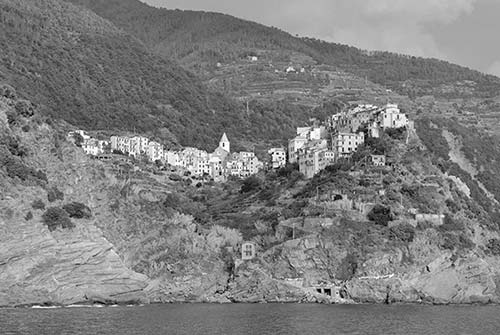
Less visited than the other Cinque Terre towns, Corniglia has fewer tourists, cooler temperatures, a laid-back main square, a few restaurants, a windy overlook on its promontory, and plenty of private rooms for rent. You don’t go to Corniglia for the beach: Its once fine beach below the station has washed away. From the town center, signs for al mare or Marina point to where a stepped path leads steeply down to sunning rocks.
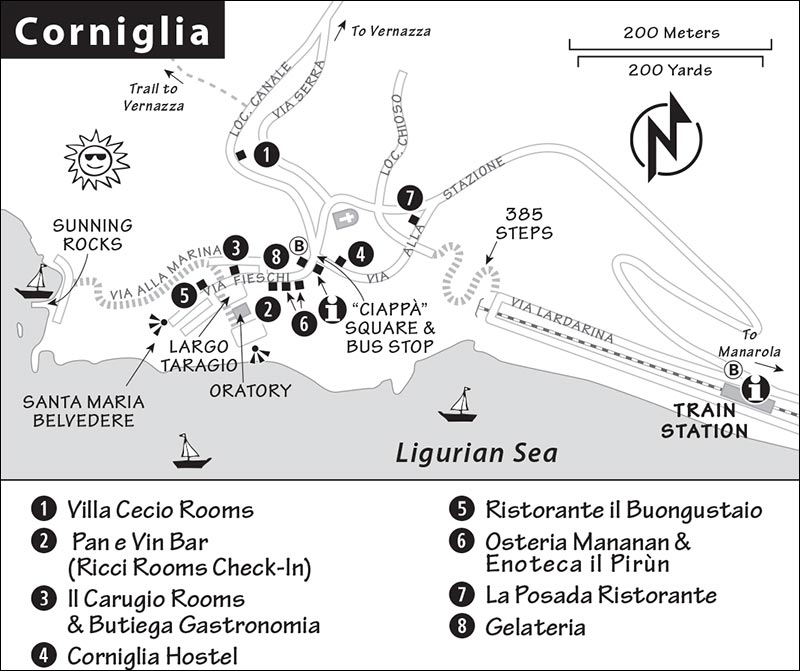
Hill-capping Corniglia is connected with its train station far below by a long set of stairs, and much easier, by a hardworking little shuttle bus. Its reliable schedule is posted both at the station and in the town. Because of the steep distance between the town and its station, and the lack of a boat dock, Corniglia is inconvenient as a home base for town-hopping.
Tourist Information: A TI/park information office is down at the train station (likely daily 8:00-20:00, shorter hours off-season). At busy times, there may also be a kiosk up in town on Ciappà square.
Hiking: From Corniglia, you can hike on the coastal trail to Vernazza. Also consider the challenging but rewarding “high road” to Manarola via Volastra. For details, see “Hiking the Cinque Terre” on here.
By Train: From the station far below town, you can take a footpath zigzagging up 385 steps (and nearly that many switchbacks) to the town in about 20 minutes. If you’d rather not walk, hop on the tiny ATC shuttle that connects the station with Corniglia’s main square, the starting point of my short self-guided walk (buy bus ticket at station TI, €1.50—or more from driver, 2-4/hour, generally timed to meet arriving trains, go quickly as bus departs when full).
If leaving Corniglia by train, review the shuttle schedule to plan your return to the station.
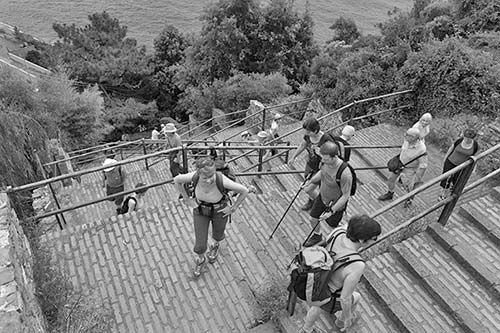
By Car: Only residents can park on the main road between the recommended Villa Cecio and the point where the steep switchback staircase meets the road. Beyond that area, anyone can park for a fee. All parking areas are within an easy and fairly level walk of the town center.
We’ll explore this tiny town—population 240—and end at a scenic viewpoint. This self-guided walk might take 30 minutes or more...but only if you let yourself browse, sample the wine, or lick a gelato cone.
• Begin near the shuttle bus stop located at a...
The gateway to this community is Ciappà square, with an ATM, old wine press, bus stop, and sometimes a TI kiosk in summer. The Cinque Terre’s designation as a national park sparked a revitalization of the town.
• Look for the arrow pointing to the centro. Stroll along Via Fieschi, the spine of Corniglia. In the fall, the smell of grapes (on their way to becoming wine) wafts from busy cellars. Along this main street, you’ll see...
As you enter Via Fieschi, a trio of neighboring gelato shops jockeys for your business. My favorite is the last one you come to (at #74, on the right), Alberto’s Gelateria (open late). Before ordering, get a free taste of Alberto’s miele di Corniglia, made from local honey; he and Cristina are also proud of their basil flavor. Their lemon slush (granita) takes pucker to new heights.
Farther along, on the left, Enoteca il Pirùn—named for a type of oddly shaped old-fashioned wine pitcher designed to aerate the wine and give the alcohol more kick as you squirt it into your mouth—is located in a cool cantina at Via Fieschi 115. Try some local wines (small tastes generally free, €3/glass). If you order wine to drink from the pirùn, Mario will give you a bib. While this is a practicality (rookies tend to dribble), it also makes a nice souvenir.
Farther along, Butiega Gastronomia (#142) is an old-fashioned grocery store/deli where Vincenzo sells organic local specialties (daily 8:00-19:30). For picnickers, they offer €5 made-to-order ham-and-cheese sandwiches and a fun antipasti misti (priced by weight). Veronica prepares specialties such as pesto daily in the shop’s tiny kitchen. You’ll find good places to picnic farther along on this walk.
• Following Via Fieschi, you’ll end up at the mellow...
On the main square, tables from two bars and a trattoria spill around a WWI memorial and the town’s old well. It once piped in natural spring water from the hillside to locals living without plumbing. What looks like a church is the Oratory of Santa Caterina. (An oratory is a kind of spiritual clubhouse for a service group doing social work in the name of the Catholic Church.) Up the stairs and behind the oratory, you’ll find a terrace that children have made into a soccer field. The stone benches and viewpoint make this a peaceful place for a picnic (less crowded than the end-of-town viewpoint, described next).
• Opposite the oratory, notice how steps lead steeply down (in 5 minutes) on Via alla Marina to sunning rocks and a small deck (with a shower and treacherous entry into the water). From the square, continue up Via Fieschi to the...
The Santa Maria Belvedere, named for a church that once stood here, marks the scenic end of Corniglia. This is a super picnic spot. From here, look high to the west (right), where the village and sanctuary of San Bernardino straddle a ridge (accessible by shuttle bus or a long uphill hike from Vernazza). Way down below are the local swimming hole and huge sunning rocks.
Because Corniglia has no harbor, its mostly humble accommodations are almost never full.
$$ Villa Cecio (pronounced “chay-choh”), sits atop the old-time Ristorante Cecio (with great views). They offer eight freshly decorated, well-priced, sizeable rooms on the quiet outskirts of town. Most rooms have postcard views, and three have terraces—worth requesting when you book. All rooms share a big rooftop view terrace (breakfast extra, four rooms have air-con, on main road toward Vernazza at Via Serra 58—keep going 200 yards beyond Ciappà square and you’ll find it on the right, tel. 0187-812-043, mobile 366-285-1178, www.cecio5terre.com, info@cecio5terre.com, Giacinto). They also rent eight more rooms in an annex on the square where the bus stops.
$ Cristiana Ricci communicates well and is reliable, renting three small, clean, and peaceful rooms—one with a terrace and sweeping view—just inland from the bus stop (family rooms, check in at Pan e Vin bar at Via Fieschi 123, mobile 338-937-6547, www.corniglia-room.com, cri_affittacamere@virgilio.it). She also rents three big, modern apartments.
$ Il Carugio has nine modern, fresh, sunny rooms in three buildings—some in the center of the village, and most with sea views. The main building offers a communal rooftop terrace with a commanding view of the coast (2-night minimum, family rooms, air-con, no breakfast but small self-service kitchen, free parking, free self-serve laundry, tel. 0187-812-293, mobile 335-175-7946 or 339-228-3803, www.ilcarugiodicorniglia.com, info@ilcarugiodicorniglia.com, gregarious Lidia). They also have a two-bedroom apartment facing the main square.
¢ Corniglia Hostel, the town’s former schoolhouse, rents 24 beds in a yellow municipal building up some steps from the square where the bus stops (find the entrance at the back of the building). Despite its institutional atmosphere, the hostel’s prices, central location, and bright, clean rooms ensure its popularity. Its hotelesque double rooms are open to anyone (breakfast extra, office open 7:00-13:00 & 15:00-1:30 in the morning, air-con, self-serve laundry, Via alla Stazione 3, tel. 0187-812-559, www.ostellocorniglia.com, ostellocorniglia@gmail.com, Andrea, Alessandro, and Elisabetta).
A typical array of pizzerias, focaccerie, and alimentari (grocery stores) line the narrow main drag. I’ve highlighted a few places for a quick bite on my self-guided walk, earlier.
For a full, sit-down meal, consider one of these restaurants.
$$$ Ristorante il Buongustaio is a good bet for dinner on the square. Daniela and the Guelfi family pride themselves in serving cucina casalinga (home cooking) and good seafood pasta and risotto (nice tables on the main square as well as in a big indoor dining room, daily 12:00-21:15, Via Fieschi 164, tel. 0187-821-424).
$$ Osteria Mananan—between the Ciappà bus stop and the main square at Via Fieschi 117—has earned a good reputation with tasty dishes and a small, stony, elegant interior (Tue-Sun 12:30-14:30 & 19:30-22:00, closed Mon, no outdoor seating, tel. 0187-821-166).
$$ Enoteca il Pirùn, on Via Fieschi, has a small restaurant above the wine bar, where Mario serves typical local dishes (Fri-Wed 12:00-16:00 & 19:00-23:30, closed Thu, tel. 0187-812-315).
$$ La Posada Ristorante offers dinner in a garden under trees, overlooking the Ligurian Sea. To get here, stroll out of town to the top of the stairs that lead down to the station (daily 12:00-16:00 & 19:00-23:00, closed Nov-March, tel. 0187-821-174, mobile 338-232-5734).
Mellow Manarola fills a ravine, bookended by its wild little harbor to the west and a diminutive hilltop church square inland to the east. Manarola is exceptional for being unexceptional: While Vernazza is prettier, Monterosso glitzier, Riomaggiore bigger, and Corniglia more rustic, Manarola hits a fine balance, giving it the “just right” combination of Cinque Terre qualities. Perhaps that’s why it’s a favorite among savvy Europeans seeking a relatively untrampled home base. The touristy zone squeezed between the cement-encased train tracks and the harbor can be stressfully congested, but head just a few steps uphill and you can breathe again.
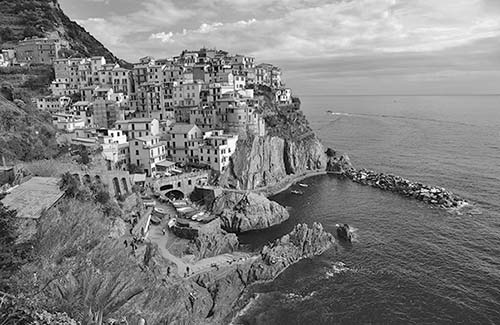
Manarola, whose hillsides are blanketed with vineyards, also provides the easiest access to the Cinque Terre’s remarkable dry-stone terraces. The trail ringing the town’s cemetery peninsula, adjacent to the main harbor, provides some of the most strikingly beautiful town views anywhere in the region. For a look at all the facets of this delightful town, follow my gentle self-guided stroll from the harbor up through town to the vineyards, and a stunning Mediterranean viewpoint.
The TI/national park information office is in the train station (likely daily 8:00-20:00, shorter hours off-season).
By Train: From the station, to reach Manarola, you’ll walk through a 200-yard-long tunnel that’s lined with interesting photos. (During WWII air raids, these tunnels provided refuge and a safe place for rattled villagers to sleep.) To reach the busy harbor—with touristy restaurants, boat dock, and the start of my self-guided walk, head left (downhill) when you come out of the tunnel.

The ATC shuttle bus runs from near the old waterwheel (halfway up Manarola’s main street), stopping first at the parking lots above town, and then going all the way up to Volastra (about 2/hour except for afternoon breaks).
By Car: You’re better off parking in La Spezia. If you’re overnighting here, ask your hotelier for parking advice. Park your car in one of the two pay lots just before town, then walk down the road to the church; from there, it’s an easy downhill walk to the main piazza, train-station tunnel, and harbor (the start of my self-guided walk), or you can wait for the shuttle bus.
From the harbor, this 45-minute self-guided walk shows you the town and surrounding vineyards and ends at a fantastic viewpoint.
• Start down at the waterfront. Belly up to the wooden banister overlooking the rocky harbor, between the two restaurants.
Manarola is tiny and picturesque, a tumble of buildings bunny-hopping down its ravine to the fun-loving waterfront. The breakwater—which attempts to make this jagged harbor a bit less dangerous—was built (with reject marble from Carrara) just over a decade ago. Notice how the I-beam crane launches the boats (which must be pulled ashore when bad weather is expected, to avoid being smashed or swept away).
Facing the water, look up to the right, at the hillside Punta Bonfiglio cemetery and park. The trail running around the base of the point—where this walk ends—offers magnificent views back on this part of town. If you see a crowd, it’s Instagram devotees who travel here from around the world (mostly Asia) to take and post their selfies.
The town’s swimming hole is just below you. Manarola has no sand, but offers the best deep-water swimming in the area. The first “beach” has a shower, ladder, and wonderful rocks. The second has tougher access and no shower, but feels more remote and pristine (follow the paved path toward Corniglia, just around the point).
• Go inland up the town’s main drag—you’ll climb a steep ramp—which is lined by classic photos of the noble people who eked out a living from the sea and this land before the arrival of tourists. The ramp leads to Manarola’s “new” square, which covers the train tracks.
Built in 2004, this square is an all-around great idea, giving the town a safe, fun zone for kids. Locals living near the tracks also enjoy a little less train noise. The mosaic in the middle of the square depicts the varieties of local fish in colorful enamel.
• Go down the stairs at the upper end of the square. On your right, notice the tunnel that leads to Manarola’s train station (and the closed Via dell’Amore trailhead). Head up...
Manarola’s main street twists up through town, lined by modest shops and filled with pooped hikers. About 100 yards up, just before the road bends sharply right, watch (on the right) for a waterwheel. This recalls the origin of the town’s name—local dialect for “big wheel” (one of many possible derivations). Mills like this once powered the local industry. As you continue up (all the way to the church), you’ll still hear the rushing waters of Manarola’s stream. Like the streams in Riomaggiore, Monterosso, and Vernazza, Manarola’s rivulet was covered over after World War II. Before that time, romantic bridges arched over its ravine. You can peek below the concrete street in several places to see the stream surging below your feet.
Across the street from the waterwheel and a bit farther up, notice the Cinque Terre Trekking shop on your left, which outfits hikers with both information and gear (for details, see “Hikes from Manarola,” later).
Around the corner is Cantine Burasca wine bar. With fine outdoor seating, it’s a good place for a little wine tasting (closed Wed, Via Discovolo 86, mobile 339-807-1261).
• Keep climbing until you come to the square at the...
The square is faced by a church, an oratory—now a religious and community meeting place—and a bell tower (with a WWI memorial etched in it), which served as a watchtower when pirates raided the town (the cupola was added once the attacks ceased). To the right of the oratory, a stepped lane leads to the town’s sizable tourist-free residential zone.
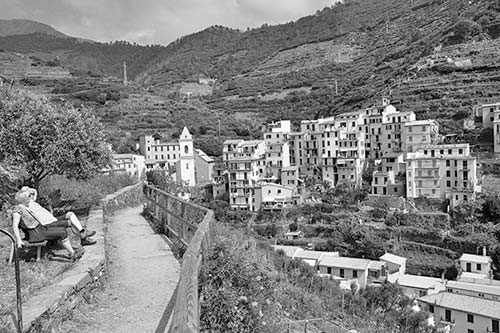
Check out the church. The Parish Church of St. Lawrence (San Lorenzo) dates from “MCCCXXXVIII” (1338). Step inside to see two altarpiece paintings from the unnamed Master of the Cinque Terre, the only painter of any note from this region (left wall and above main altar). While the style is Gothic, the work dates from the time of Michelangelo, long after Florence had entered the Renaissance. Note the humble painted stone ceiling, which replaced the wooden original in the 1800s. It features Lawrence, patron saint of the Cinque Terre, with his grill, the symbol of his martyrdom (he was roasted on it).
• With the bell tower on your left, head about 20 yards back down the main street below the church and find a wooden railing on the right. It marks the start of a delightful stroll around the high side of town, and back to the seafront. This is the beginning of the...
Don’t miss this experience. Simply follow the wooden railing, enjoying lemon groves and great views. Along the path, which is primarily flat, you’ll get a close-up look at the region’s famous dry-stone walls and finely crafted vineyards (with dried-heather thatches to protect the grapes from southwest winds). Smell the rosemary. Study the structure of the town, and pick out the scant remains of an old fort. Notice the S-shape of the main road—once a riverbed—that flows through town. The town’s roofs are traditionally made of locally quarried slate and held down by rocks during windstorms.
Halfway along the lip of the ravine, a path marked Panoramico Volastra (Corniglia) leads steeply up into the vineyards (a challenging route that leads to the tiny hamlet of Volastra and then to Corniglia—described on here).
Stick with your level path, passing a variety of simple wooden religious scenes, the work of local resident Mario Andreoli. Before his father died, Mario promised him he’d replace the old cross on the family’s vineyard. Mario has been adding figures ever since. On religious holidays, everything’s lit up: the Nativity, the Last Supper, the Crucifixion, the Resurrection, and more. Some of the scenes are left up year-round. (You can see more of his figures across the ravine, gathered together in a little open patch between buildings.) High above, notice ancient terraces that line the terrain like a topographic map.
• Continue on the trail as it winds down to the cemetery. While the cemetery is closed to the public, you can stop by the gate for a peek inside.
Ever since Napoleon—who was king of Italy in the early 1800s—decreed that cemeteries were health risks, Cinque Terre’s burial spots have been located outside the towns. The result: The dearly departed generally get first-class sea views. Each cemetery—with evocative photos and finely carved Carrara marble memorial reliefs—is worth a look. (While others are high above their towns, Manarola’s—on this little low-altitude bluff—is the most easily accessible.)
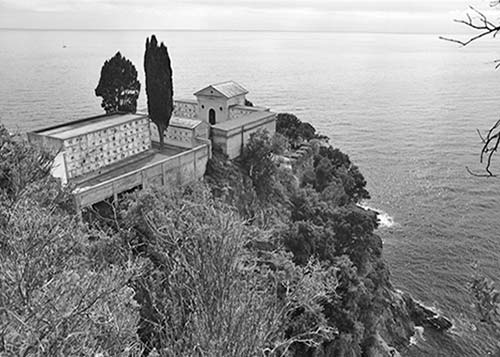
In cemeteries like these, the real estate is similar to that for the living: The wealthy get their own piece of land (a grave), regular people get the equivalent of a condo (with their remains parked in a niche called a loculus), and the poor and forgotten end up tossed in a communal ossuary. Because of the tight space, spots are rented and a person’s remains are allowed to stay only as long as their loved ones care enough to pay the rent. (No rent means you end up in the ossuary, making room for the newly dead with family willing to pay). Traditionally, locals make weekly visits to loved ones here, often bringing flowers. The rolling stepladder makes access to top-floor loculi easy.
• From the cemetery follow the steep and narrow stairs (through the green gate immediately below the cemetery) and walk out onto the bluff.
This point offers some of the most commanding views of the entire region. To find the best vantage point, walk out toward the water through a park (playground, drinking water, WC, and picnic benches). An inviting and recommended bar, Nessun Dorma, fills a long narrow terrace with people enjoying the vista.
Your Manarola finale is the bench at the tip of the point. (It’s often congested with travelers who have taking a photo from this point on their Instagram bucket list.) Pause and take in the view.
• From here steps go down and the path winds scenically back to the harbor, where we started.
The coastal trail from Manarola—leading to Corniglia in one direction and to Riomaggiore in the other (the famous Via dell’Amore)—has been closed for years due to landslides. But you can still enjoy hiking from here.
One of my favorite easy hikes is to head up into the vineyards above Manarola, then drop down into the town cemetery, enjoying great views on the way. This route is outlined in my “Manarola Walk,” earlier.
For a longer hike, consider taking the high route to Corniglia via Volastra (much easier if you ride the shuttle bus, rather than hike, up to Volastra). For details, see “Hiking the Cinque Terre” on here.
Hiking Gear and Tips: A wonderful resource for hikers, Cinque Terre Trekking is near the top of the main street (halfway up to the church). Christine and Nicola are generous with hiking advice, and fill their shop with all the hiking gear you may need: boots, clothes, walking sticks, maps, and more. If you’re serious about hiking, stop in here to confirm your plans and to gear up (daily 11:00-13:00 & 14:00-19:00, shorter hours off-season, Via Discovolo 108, tel. 0187-920-834, www.cinqueterretrekking.com, info@cinqueterretrekking.com).
Entrepreneurial Simone at the Nessun Dorma cantina (perched next to the cemetery at the most scenic edge of Manarola) leads a pesto-making workshop for up to 30 people at 10:30, followed by lunch at noon. The setting is unforgettable, making pesto in the place of its origin is exciting, and you get to eat what you make plus a tagliere plate of cold cuts (€50/person, includes wine, no class on Tue, reserve ahead at www.nessundormacinqueterre.com or call mobile 340-888-4133, class cancelled in bad weather).
Arbaspàa arranges vineyard wine tastings, cooking classes (6-person minimum), fishing trips, paragliding, rock climbing, and more (see website for options and book in advance, www.arbaspaa.com; Explora office at Via Discovolo 204, tel. 0187-920-783).
To get to the dock and the boats that connect Manarola with the other Cinque Terre towns, find the steps to the left of the harbor view—they lead down to the ticket kiosk. Continue around the left side of the cliff (as you’re facing the water) to catch the boats.
Manarola has some of the most appealing, well-run accommodations in the region (rivaling Monterosso’s). Like the others, it also has plenty of private rooms (Airbnb has consumed the market). If you need breakfast, the recommended Bar Caffè Aristide is your best choice. Otherwise grab a coffee and croissant along the main drag.
This area is a 10-minute steeply uphill hike from the train station—just huff up the main drag to the church. All are within a five-minute walk from there.
$$$$ La Torretta offers 14 trendy, upscale rooms (most with private deck) that cater to an elite clientele. Probably the most elegant retreat in the region, this peaceful refuge has all the comforts for those happy to pay, including a communal hot tub with a view. Guests enjoy a complimentary snack and glass of prosecco on arrival, an ample breakfast buffet, daily happy hour, and stocked minibars. Each chic room is distinct (top-end family suite, book several months in advance, closed Dec-March; on request, they’ll pick you up at the station tunnel in a golf cart; on Piazza della Chiesa beside the bell tower at Vico Volto 20, tel. 0187-920-327, www.torrettas.com, torretta@cdh.it, Sonia).
$$$ B&B Da Baranin, with eight good rooms and one apartment, is a bit too pricey but has sleek modern style and a nice breakfast terrace (family rooms, air-con, Via Aldo Rollandi 29, tel. 0187-920-595, www.baranin.com, info@baranin.com, Sara).
$$ Aria di Mare Rooms rents four sunny, tidy, well-equipped rooms and two apartments a few steps beyond Trattoria dal Billy at the very top of town. While it’s a steep hike up (high above the tourists), this is an excellent value. Three rooms have spacious terraces, and all can enjoy the knockout views from lounge chairs in the front yard (RS%, no breakfast but tea/coffee service in room, air-con, up the stairs at Via Aldo Rollandi 149, mobile 349-058-4155, www.ariadimare.info, info@ariadimare.info, Maurizio; ask at Billy’s if no one’s home).
These options line up along (or near) the main street, between the harbor and the church. While in a less atmospheric area than the ones near the church, they’re closer to the station—and therefore a bit handier for those packing heavy.
$$$ Albergo Ca’ d’Andrean is quiet, comfortable, and chic. It has 10 big, sunny, tranquil rooms, with lots of tile. Public spaces artfully display family artifacts, and the cool garden oasis comes complete with lemon trees. If you don’t mind stairs, consider one of their pricier top-floor rooms, with great terrace views (breakfast extra, air-con, up the hill at Via Discovolo 101, tel. 0187-920-040, www.cadandrean.it, info@cadandrean.it, Simone, Ariana, and Nicola).
$$$ Marina Piccola, a lesser value, offers 12 stylish rooms near the bustle of the square on the water (some with sea views). It’s expensive and impersonal, but it’s handy to the harbor area (air-con, Via Birolli 120, tel. 0187-920-770, www.hotelmarinapiccola.com, info@hotelmarinapiccola.com, Jessica and Micaela).
$$ Da Paulin, run by charming Donatella (who makes a mean limoncello) and Eraldo (the town’s retired policeman), has three surprisingly modern, fresh, well-equipped, hotelesque rooms with a large and inviting common living room. They also rent three apartments (with fans). This fine value is at the bend in the main street, a five-minute hike above the train tracks (breakfast extra, air-con, Via Discovolo 126, mobile 334-389-4764, www.dapaulin.it, prenotazioni@dapaulin.it).
$$ 5 Terre Pelagos has eight pastel, shabby-chic rooms in an awkward building down a side lane. Built into the side of the mountain, the common room has a caveman ambience; some rooms come with view terraces (air-con, Via dei Mulini 26, mobile 335-122-6490, www.5terrepelagos.com, info@5terrepelagos.com, Edoardo).
$$ Hotel il Saraceno, with seven spacious, utilitarian rooms, is a deal for drivers. Located above Manarola in the tiny town of Volastra (chock-full of vacationing Germans and Italians in summer), it’s serene, clean, and right by the shuttle bus to Manarola (free parking, air-con, tel. 0187-760-081, www.thesaraceno.com, hotel@thesaraceno.com, friendly Antonella).
Via Discovolo, the main street climbing up through town from Piazza Capellini to the church, is lined with simple places and some small grocery stores where you can browse for a picnic. This strip—and the short street between the elevated square and the harbor—also has several focaccia, pizza-by-the-slice, and fried-goodies carryout shops that are fine for a quick lunch. Bar Caffè Aristide is the busiest for breakfast. And the most enticing gelateria in town is Sorbetteria 5 Terre Gelateria (a couple of doors away).
Most of the town’s (touristy) restaurants are concentrated between Piazza Capellini and the harbor. The Scorza family works hard at $$ Trattoria il Porticciolo (Thu-Tue 12:00-21:30, closed Wed, Via Birolli 92, tel. 0187-920-083) and at their contemporary cafè, cheap and fast, across the way. At the harborfront, $$$ Marina Piccola is famous for great views, lousy service, and overcharging naive tourists.
$$$ Ristorante di Aristide, right on Piazza Capellini, is run by three generations of hardworking women and offers a trendy atmosphere and a pleasant outdoor setting, with a view of budding soccer stars rather than harborfront glitz (Fri-Wed 12:00-22:30, closed Thu, Via Discovolo 290—you run right into it from the train tunnel, tel. 0187-920-000).
$$ Bar Caffè Aristide, next door, is a busy and modern little place. They have indoor and streetside seating, a lighter menu (see daily specials on blackboard), and breakfast options (Fri-Wed 8:00-11:30 & 12:00-16:00, closed Thu, same address and phone number; charming Elena, Mamma Monica, and Nonna Grazia). Sharing a serious kitchen with Ristorante di Aristide gives this little joint an extra dose of quality.
$$$ Trattoria dal Billy, the best restaurant in town, is in the residential zone high above the touristy action. Many find it’s worth the climb for Edoardo and chef Enrico’s homemade black pasta with seafood and squid ink, green pasta with artichokes, and homemade desserts. Their antipasto misto di mare comes with a dazzling array of seafood treats—each one perfectly executed. Billy’s outdoor terraces offer commanding views over Manarola, while across the street an elegant, glassy dining room is carved into the rock. Either setting is perfect for a romantic candlelight meal. Reservations are a must (Fri-Wed 12:00-15:00 & 18:00-22:00, closed Thu, Via Aldo Rollandi 122, tel. 0187-920-628, www.trattoriabilly.com).
$$ Nessun Dorma Cantina is scenically perched under the cemetery and above the harbor. While they have no kitchen, Simone and his staff keep the masses happy with bruschetta, cold cuts, salads, and lots of drinks (Wed-Mon 12:00-21:00, closed Tue, Localita Punta Bonfiglio, mobile 340-888-4133). Simone runs a morning pesto-making class (described earlier, under “Experiences in Manarola”).
The most substantial town of the five, Riomaggiore is a disappointment from the train station. But walk through the tunnel next to the tracks, and you’ll discover a more real and laid-back town than its more touristy neighbors. The main drag, while traffic-free, feels more urban than “village,” and surrounding the harbor is a fascinating tangle of pastel homes leaning on each other like drunken sailors. Despite Riomaggiore’s workaday soul, the views back on its harbor from the breakwater—especially at sunset—are some of the region’s prettiest.
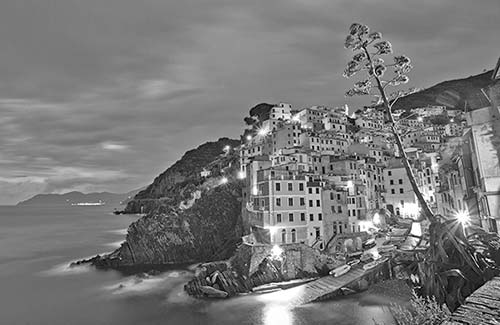
The info point in the station is for train info and tickets. The adjacent striped building, with a national park shop and info desk, is best for visitor information (both open daily 8:00-20:00, shorter hours off-season). Amy and Francesco at Riomaggiore Reservations or Ivo and Alberto at the recommended Bar Centrale are also good sources if you’re in a pinch.
By Train: Riomaggiore’s train station is separated from the town center by a bluff. To get to the center, take the pedestrian tunnel that parallels the rail tunnel. You’ll exit at the bottom of Via Colombo; most recommended accommodations are a short hike up this steep main drag. If you’re staying near the top of town, you can catch the sporadic shuttle bus at the bottom of Via Colombo and ride it partway up.
For a scenic route into town (for those not carrying luggage), take my “Riomaggiore Walk,” later.
By Car: Day-trippers park at the two-story pay-and-display lot above town (€5/hour, €35/day). If you’re staying overnight, your hotel may have parking. It is easier to park at La Spezia’s train station (see the next chapter) and ride the train in.
Baggage Storage: You can check your bag at the casually run deposito bagagli office—it’s behind the café/bar that’s straight ahead as you exit the station (your fee supports the sports club, daily 9:00-12:00 & 14:00-19:00—confirm times, closed in winter).
Services: There are three public pay WCs in town: at the station and at the top and bottom of Via Colombo.
Laundry: A self-service launderette is on the main street (daily in summer 8:00-20:00, shorter hours off-season, Via Colombo 107).

Here’s an easy self-guided walk that loops up and over, taking the long and scenic way from the station into town. You’ll enjoy some fine views before strolling down the main street to the harbor.
• Start at the train station. (If you arrive by boat, cross beneath the tracks and take a left, then hike through the tunnel along the tracks to reach the station.)
With your back to the sea and station, look left and notice the stairs climbing up just past the station building. These lead to the easy (but closed) trail to Manarola, the Via dell’Amore.
Hike up the main street. Listen to the paved-over creek under your feet and at the first turn see the waterfall (and turtles in the cage). Farther along is a close-up look at dry-stone rockery work. Look down on the historic train line. Soon you’ll pass the top of a concrete elevator tower (an example of local ineptitude—built but never reliably functional and now abandoned). A bit farther, you’ll arrive at a fine viewpoint, with spectacular sea views.
• When you’re ready to move on, hook left around the bluff; rounding the bend, ignore the steps marked marina seacoast (which lead to the harbor) and continue another five minutes along the main (level) path toward the church. Along the way, consider a steep little side trip to the castle.
A steep stepped lane on the left leads to the castle (€2, daily 10:30-13:30). Taking this five-minute side trip, you’ll find a humble art and heritage exhibit, the town’s only well-preserved mural by Argentinian artist Silvio Benedetto, great sea views, and the tiny church of San Rocco (built for plague victims, and therefore outside of the town walls). More of Benedetto’s murals are near the City Hall.
Back down on the smooth and level lane, you’ll go by the City Hall and several decaying murals (also by Silvio Benedetto), celebrating the heroic grape-pickers and fishermen of the region. These beautiful murals, with subjects modeled after real-life Riomaggiorians, glorify the nameless workers who constructed the nearly 300 million cubic feet of mortarless, dry-stone walls that run throughout the Cinque Terre. These walls give the region its characteristic muri a secco terracing for vineyards and olive groves. Unfortunately, the murals are not aging well.
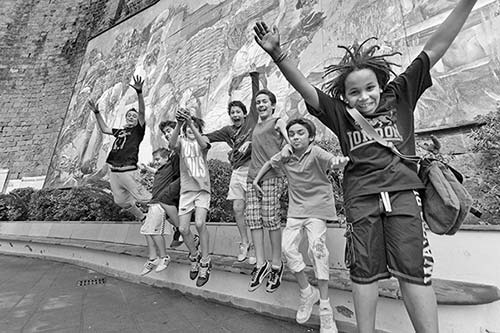
Pause at the big terrace to enjoy the views of town and perhaps lots of local kids (the preschool is nearby). The major river of this region once ran through this valley, as implied by the name Riomaggiore (local dialect for “river” and “major”). As in the other Cinque Terre towns, the main street covers its rio maggiore, which carved the canyon now filled by the town’s pastel high-rises. The romantic arched bridges that once connected the two sides have been replaced by a practical modern road. Other than that, the town is beautifully preserved.
The church, while rebuilt in 1870, was first established in 1340. It’s dedicated to St. John the Baptist, the patron saint of Genoa, the maritime republic that once dominated the region.
• Continue straight past the church and along the narrow lane leading down to the town’s main street...
Heading down the hill on Via Colombo, you’ll pass several handy fast-food joints. (A hot political issue lately: too many fast-food joints and no place to sit.) Farther along, the big covered terrace on the right belongs to the recommended Bar Centrale, a popular hangout for international visitors day or night.
As you round the bend to the left, notice the old-timey pharmacy just above (on the right, with a good bakery underneath). On your left, at #199, peek into the Il Pescato Cucinato shop, where Laura fries up her husband Edoardo’s fresh catch; grab a paper cone of deep-fried seafood as a snack. Where the road bends sharply right, notice the bench on your left (just before La Zorza Café)—the hangout for the town’s old-timers, who keep a running commentary on the steady flow of people. Straight ahead, you can already see where this street will dead-end. The last shop on the left, Alimentari Franca (at #251), is a well-stocked grocery where you can gather the makings for a perfect picnic out on the harbor.
Where Via Colombo dead-ends, look right to see the tunnel leading back to the station. Look left to see two sets of stairs. Climb the “up” stairs to a parklike square (Piazza Vignaioli) built over the train tracks, which provides the children of the town a bit of level land on which to kick their soccer balls and to learn to ride a bike. The murals above, marking the town’s middle school, celebrate the great-grandparents of these very children—the salt-of-the-earth locals who earned a humble living before the age of tourism. Riomaggiorians are proud that they are the only Cinque Terre town with their own middle school—in the other towns, kids are sent away to school much earlier.
• Take the “down” stairs to the...
This most picturesque corner of Riomaggiore features a tight cluster of buildings huddling nervously around a tiny square and harbor. Because Riomaggiore lacks the naturally protected harbor of Vernazza, when bad weather is expected, fishermen pull their boats up to the safety of the little square. This is quite an operation, so it’s a team effort—the signal goes out, and anyone with a boat of their own helps move the whole fleet. Sometimes the fishermen are busy beaching their boats even on a bright, sunny day—an indication that they know something you don’t.
A couple of recommended restaurants—with high prices and memorable seating—look down over the action. Head past them and up the walkway along the left side of the harbor, and enjoy the views back at the town’s colorful pastel buildings, with the craggy coastline of the Cinque Terre just beyond. The best views are from up top, at the edge of the bluff. Below you, the breakwater (made of reject marble blocks from the famous nearby quarries of Carrara) curves out to sea, providing a bit of protection for the harbor. These rocks are popular with sunbathers by day and romantics and photographers at sunset.
For a peek at Riomaggiore’s beach, continue around the bluff on this trail toward Punta di Montenero, the cape that defines the southern end of the Cinque Terre. As you walk, you’ll pass the rugged boat landing and eventually run into Riomaggiore’s uncomfortably rocky but still inviting beach (spiaggia). Ponder how Europeans manage to look relaxed when lounging on football-sized “pebbles.”
For an easy walk along the lip of the one-time river ravine, take Via di Loca, which veers off the main drag at the top of town (directly across from the stairs at the upper end of Via Colombo). This leads in just a few minutes to the town playground (parco giochi), benches, neighborhood pea patches, and pleasant views over town (especially at sunset). There’s also a steep staircase from here up to the town cemetery; from there, an even steeper trail runs all the way up to the town’s sanctuary (or see the easier alternative—described next).
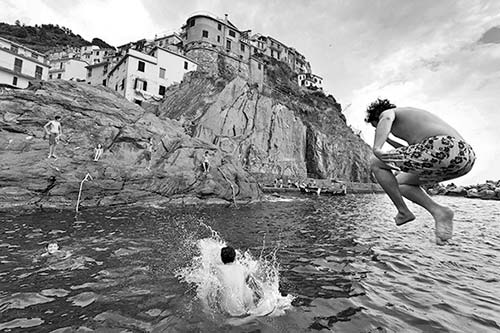
For a scenic one-hour trail that rises from Riomaggiore to the 14th-century Madonna di Montenero sanctuary, high above the town, take the main road inland until you see signs at the roundabout at the top of town; or ride the shuttle bus 12 minutes from the town center to the sanctuary trail, then walk uphill another 20 minutes (great picnic spot up top).
Riomaggiore’s rugged and tiny “beach” is rocky, but it’s clean and peaceful. It’s just around the bluff from the harbor, past the boat landing—to find it, see the end of my self-guided walk, above. There’s a shower here in the summer, and another closer to town by the boat landing—where many enjoy sunning on and jumping from the rocks.
Diving Center 5 Terre rents kayaks as well as snorkeling and scuba equipment; they also lead guided dives of the protected marine waters nearby (daily May-Sept 9:00-18:00, open only in good weather, likely weekends only in shoulder season, office down the stairs and under the tracks on Via San Giacomo, tel. 0187-920-011, www.5terrediving.it).
With a youthful spirit and lively evening bustle, Riomaggiore has an enjoyable night scene. Stroll the main drag, scope out these listings (serving €6-8 cocktails), and find the one that appeals. Several of these places have full menus if you want to eat.
Bar Centrale, run by sociable Ivo, Alberto, and the gang, offers “nightlife” any time of day—it’s a magnet for tourists. Ivo, who lived in the Bay Area, fills his bar with San Franciscan rock and a fun-loving vibe; it feels a little like the village’s living room (great mojitos, daily 7:30-late, Via Colombo 144).
Bar & Vini A Piè de Mà, above the train station at the now closed Via dell’Amore trailhead, has piles of charm, frequent music, and stays open until midnight from June through September.
More Bars and Cafés: Near the bottom of Via Colombo, facing each other, are the noisy La Zorza Café (appealing to international tourists with thumping music and freestyle bartender) and the classier Bar O’Netto (geared more for young locals, with a mellower vibe and nice outdoor seating). Higher up on Via Colombo (at #76), Vertical Lounge Bar has a lively and loose ambience, light food (a good aperitivo buffet at happy-hour time), and a fine people-watching perch near the top of the promenade zone. And at sunset, you can’t beat La Conchiglia—the simple café/bar on the bluff overlooking the harbor—a perfect location for watching the sun disappear into the Ligurian Sea and the lights of Monterosso twinkling on the horizon.
Riomaggiore has few hotels worth your time; I recommend staying in one of the town’s many private rooms for rent. Very few private rooms include breakfast.
A couple of room-booking agencies—with relatively predictable office hours, English-speaking staff, and email addresses—are next to each other on Via Colombo. Each manages a corral of local rooms for rent; the quality and specific amenities can vary wildly, so get a complete picture of the room before you commit. It’s smart to settle up the day before you leave in case they’re closed when you need to depart. Expect lots of stairs—ask how many when you book.
$$ Edi’s Rooms manages four double rooms and eight apartments. You pay extra for views (most rooms with air-con, office open daily in summer 9:00-13:00 & 14:00-19:30, closed Nov-Feb, reception at Via Colombo 111, tel. 0187-920-325, www.appartamenticinqueterre.net, edi-vesigna@iol.it).
$ Riomaggiore Reservations, run with care by American expat Amy and her Italian husband, Francesco, offers six rooms and four apartments (RS%, cash only, reception open daily 9:00-13:00 & 14:00-17:00 in season, air-con, Via Colombo 181, tel. 0187-760-575, www.riomaggiorereservations.com, info@riomaggiorereservations.com). They’re a great resource for info on hiking and other activities.
Another option is to book directly with someone who rents just a few rooms of their own.
$$ Alla Marina is Riomaggiore’s best value, with five rooms—most with sea views—at the top of one of the tall, skinny buildings that rise up from the harbor. The furnishings are a combination of modern and nautical, and friendly brothers Sandro and Andrea take pride in running a tight ship. They also rent four apartments (RS%—free breakfast at nearby café, air-con, pay parking, office open 9:00-18:00, Via San Giacomo 61—ask about the easier back-door entrance, mobile 328-013-4077, www.allamarina.com, info@allamarina.com). They also rent several rooms in other parts of town.
$$ Casato Bapò has three airy, spacious rooms with unobstructed views at the top of town near the Church of San Giovanni. They’re on the fourth floor, but accessible via the public elevator nearby (Via Pecunia 116, mobile 340-705-6723, www.casatobapo.com, casatobapo@gmail.com, Sabrina).
$$ Il BoMa—named for the owners, American Maddy and her Italian husband, Bombetta, has three old-fashioned rooms along the main drag (one cheaper room with private bath down the hall, air-con, up three flights at Via Colombo 99, tel. 0187-920-395, mobile 320-0748826, www.ilboma.itcom, info@ilboma.it). They also rent two nearby apartments.
$$ La Dolce Vita offers six modern, good-value rooms on the main drag, plus two apartments elsewhere in town (some with air-con, no breakfast, open daily 9:30-19:30—if they’re closed, they’re full; Via Colombo 167, tel. 0187-920-935, agonatal@libero.it, helpful Giacomo and Simone).
Harborfront dining comes with slightly higher prices, a dressy ambience, and glorious views. These two eateries share the same owner; the first one’s menu is more traditionally Italian, while the second is a bit more modern.
$$$$ Enoteca & Ristorante Dau Cila (pronounced “dow CHEE-lah”) is decked out like a black-and-white movie set in an old boat shed with extra tables outside on a rustic deck over dinghies. Try their antipasto specialty of several seafood appetizers (dinner only) and listen to the waves lapping at the harbor below (cheaper lunch menu with salads and bruschette, daily 12:00-24:00, Via San Giacomo 65, tel. 0187-760-032, Niccolo).
$$$$ Rio Bistrot, small and intimate at the top of the harbor, tries to jazz up its Ligurian cuisine with international influences. You can order à la carte from the short but well-designed menu, or try their €39 tasting menu (simpler and cheaper lunch menu, daily 12:00-16:00 & 18:00-22:00, Via San Giacomo 46, tel. 0187-920-616, Manuel).
$$ Trattoria la Grotta, right in the town center (with no view), has a passion for anchovies and mussels. You’ll enjoy reliably good food surrounded by historical photos and wonderful stonework in a dramatic, dressy, cave-like setting (daily 12:00-14:30 & 17:30-22:30, closed Wed in winter, Via Colombo 247, tel. 0187-920-187).
$$ Bar Centrale is a casual, family-friendly place for hamburgers, salads, and pesto. They also have a gelateria on site (long hours daily, see listing earlier, under “Nightlife in Riomaggiore”).
Light Meals: Various handy carryout eateries along the main drag offer good lunches or snacks. $ Primo Piatto, at the top of town, offers takeaway handmade pastas and sauces, cooked to order on the spot. It’s cheap and delicious (Wed-Mon 10:30-19:30 or later, closed Tue, Via Colombo 72, Roberta). For deep-fried seafood in a paper cone, $ Il Pescato Cucinato is where Edoardo fishes and his wife, Laura, fries (chalkboard out front explains what’s fresh, daily 11:20-20:30, near the bottom of Via Colombo at #199). A few doors away, $ Tutti Fritti serves only fried nibbles, including fish (daily 10:00-21:00, Via Colombo 161, Andrea and Isabella).
Picnics: Groceries and delis lining Via Colombo sell food to-go for a picnic at the harbor or beach. Co-op grocery stores (several on the main drag) have the best prices. For a more appetizing selection and good service, head to Alimentari Franca, on the main street by the train-station tunnel (daily 8:00-20:00, Via Colombo 251).
Breakfast: Most of my recommended accommodations don’t serve breakfast—and those that do often simply leave a coffee kettle and some basic continental breakfast fixings in your room. For eggs or a good croissant-and-espresso fix, drop by Bar Centrale (described earlier); or Bar Stazione, at the train station.
$$ Bar & Vini A Piè de Mà, at the trailhead on the Manarola end of town, is good for a scenic light bite or quiet drink at night. The bar, with great outdoor seating, is self-service: Head into the bar to place your order, then bring it out to your preferred perch (daily 10:00-20:00, June-Sept until 24:00, closed Mon-Tue off-season, tel. 0187-921-037). Enjoy a meal on its dramatically situated terrace for an indelible Cinque Terre memory.
